Canadians Wary of Contact Tracing
40% unlikely to to trust organizations with data
Provincial and federal governments will need to do more to convince Canadians to share personal data and participate in digital contact tracing.
Data from Caddle’s latest survey of our 10,000 member daily panel shows that 35% of Canadians are completely unfamiliar with contact tracing, while less then half feel it is ethical — even during a pandemic.
This will become increasingly significant in the weeks ahead as governments explore the possibility of digital contract tracing services.
Two weeks ago, Alberta became the first province to introduce a voluntary contact tracing app. The service uses bluetooth technology to trace people who may have been exposed to COVID-19.
However less than 40% of people trust organizations to protect their data and, perhaps surprisingly, almost one in five feel contact tracing has had a negative effect on the world.
The good news is that the more Canadians know about contact tracing, the better they feel about it.
How familiar are we with contact tracing?
Overall, about 65% of Canadians declared some degree of familiarity with contact tracing.

With its use of mobile technology, you would be forgiven for thinking younger Canadians would be most familiar with the concept.
In fact, Gen Z Canadians are the group least familiar with contact tracing with 39% saying they were aware of it. Meanwhile residents of Quebec, the province with the highest number of cases in Canada, has highest proportion of people unfamiliar with it.
Any knowledge gap matters, because people’s attitudes are shaped by how much they know.
Is contact tracing ethical?
Overall, panel members were undecided on the ethics of contact tracing (44%), although a higher proportion see it as ethical (39%) than unethical (16%).
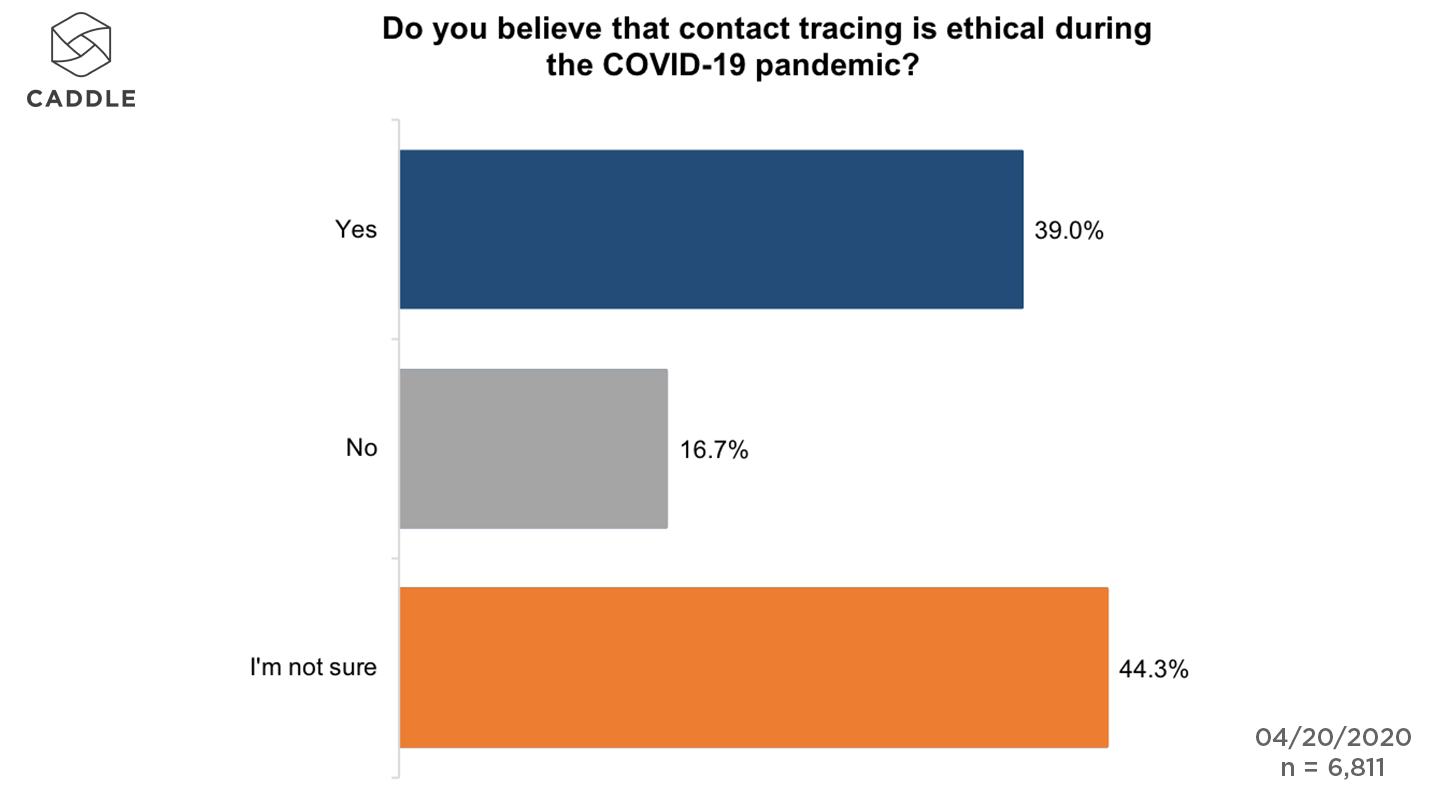
However, simply filtering out respondents without any familiarity with contact tracing shifts the numbers. More than half of those with any familiarity view contact tracing as ethical, compared to 30% undecided and 18% who see it as unethical.
Is our data safe?
The same picture emerges when it comes to whether Canadians trust that their data is safe.
Those with even a little familiarity with contact tracing are more likely to trust organizations with their data, than distrust.

More than half of those with no familiarity with contact tracing said they were unlikely to trust an organization with their data. When looking at panel members with at least a slight understanding of what contact tracing is, this figure falls to 30%.
Is contact tracing a good thing?
Even if many are still relatively unfamiliar with contact tracing, what is their gut feeling about it? Do people generally perceive it as something that is beneficial?
Given the roll out of apps in countries such as Australia, Singapore, South Korea and the UK as a means to limit the spread of COVID and enable lifting of restrictions, this might seem like a no-brainer. However the results are a little surprising.
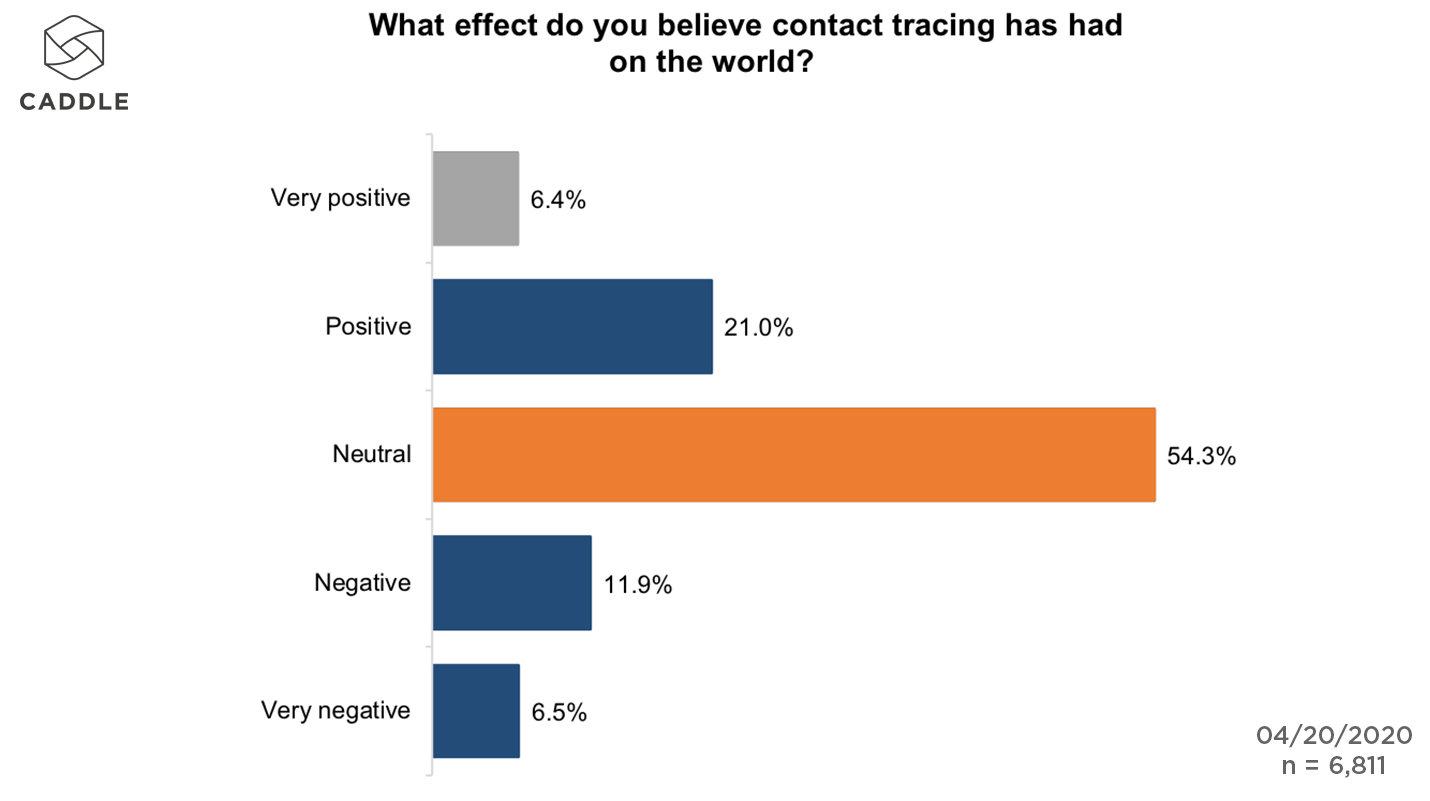
While the overall sentiment leans towards positive, nearly 20% of panel members believe contact tracing has had a negative impact on the world.
Even excluding the answers of those who told us they were not at all familiar with the concept, 14.4% of respondents saw it as a negative, suggesting a deeper issue such as privacy concerns affecting the opinion of a small but significant proportion of people.
What does this mean?
Authorities looking to run digital contact tracing initiatives will need to couple this with a wider education initiative.
There is a clear relationship in the data between familiarity with contact tracing and positive sentiment towards it. Given that Gen Z Canadians are the most unfamiliar with it, this is more nuanced than a cliche about older generations being more resistant to technology.
The education piece needs to be about why it is necessary, how it can help, and the role that it has played elsewhere in the world.
Concerns about privacy and ethics will be hard to placate for all people. But with the right educational campaign, governments could encourage enough take up to make contact tracing services a viable option to limit the spread of COVID-19.
COVID-19 Insights: Attitudes shift on homeschooling
- Parents outlook 30% more positive than before closures
With schools closed across Canada, learning has looked very different in the wake of the COVID-19 pandemic.
It isn’t just the disrupted academic year, but the challenge parents nationwide face to help their kids to keep studying.
Roughly two months into school closures, how do Canadian parents feel?
In this week’s COVID report we look at what the parents on Caddle’s 10,000 member daily survey panel told us about their experiences with home learning.
Despite the disruptions, including financial hardship and the need for sudden new purchases, parents were positive overall about the situation.
How are schools doing?
Overall, parents are positive about how schools have handled the COVID-19 crisis.
Looking specifically at parents who said they had been directly impacted by school closures, we found 43% were positive about how schools had handled the situation. This compares with 16% with a negative outlook.

Albertans were the most positive about their schools’ response, with half of parents holding a positive view, compared to 39.6% in Ontario.
However, concerns remain across the country about the impact of the closures on education. 80% of parents said they believed the COVID-19 crisis had impacted the quality of education.
The Financial Impact
School closures are putting a financial burden on parents, too. Of those directly impacted by the shutdown, 36% said they had experienced financial hardship as a result.
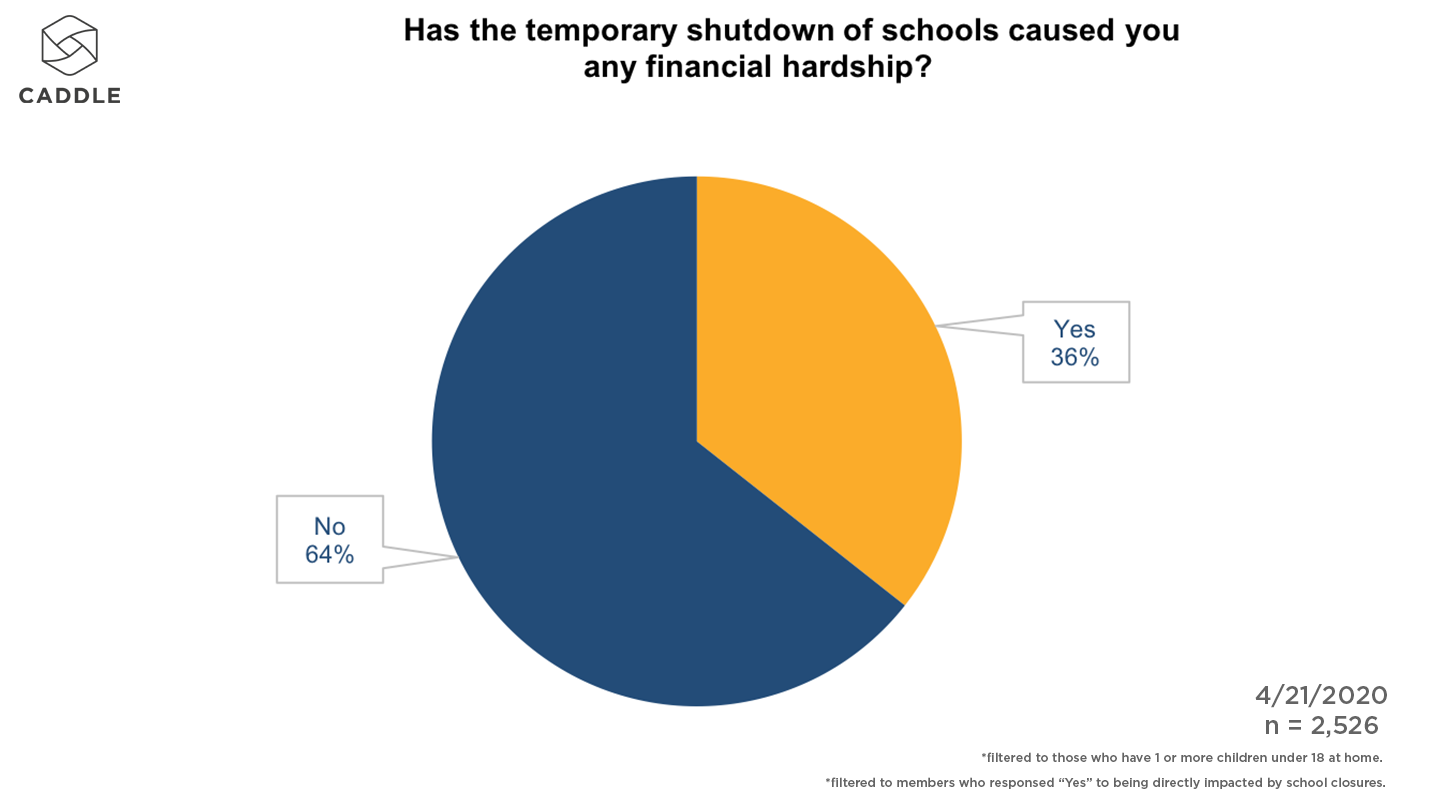
Part of this would undoubtedly be explained by the broader economic situation, in addition to increased challenges between home and work life for parents. But there is another possible factor: additional purchases parents have had to make to facilitate home study.
Purchasing school supplies
Since Canadian schools closed, just over a third of parents on the panel have had to purchase or borrow school supplies. About half of parents anticipate not needing to purchase any school supplies, but what will the other half need to buy?
Accessories such as pens, books, and paper topped the list with just under a quarter of parents anticipating they would need to buy them.

But there are some notable bigger purchases on the list, too. Almost a fifth of parents anticipated needing to buy either a laptop (12.9%) or a printer (6.7%).
Perhaps as a result of the economic situation, or the nature of the purchases, brand name is not a big factor in these purchases. Instead parents are making school supplies purchases on the basis of price and availability.
How are parents feeling about homeschooling?
Despite the disruption and financial costs, parents have, if anything, become more positive about homeschooling.
We asked parents to rate how they felt about homeschooling before the closures compared to now.
What we see is a shift towards more positive views among those directly affected. Just over a quarter (25.7%) said they felt positively about homeschool prior to school closures. After two months of closures, this has risen to 33.3% — a 30% rise in positive sentiment.
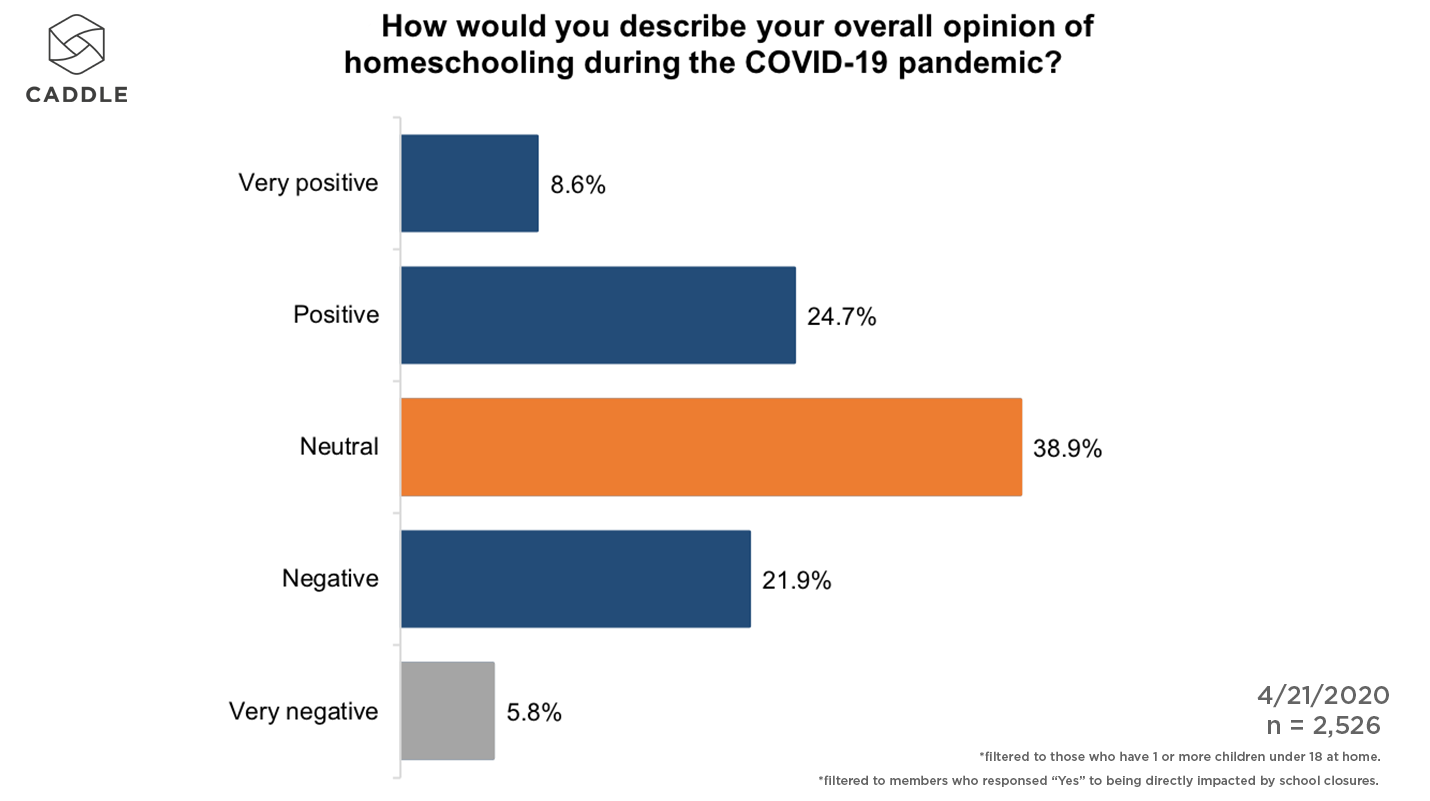
This means there is now a slight net positive feeling towards homeschooling from parents affected by closures (33.3% positive vs 27.7% negative).
However this is not because the experience has changed minds from negative to positive. Most of the shift has come from those who told us they were undecided prior to closures.
The financial burden of school closures does not appear to be shaping these views. The net positive score for those who reported financial hardship due to the shutdown is higher for this group than those who did not report any financial hardship.
Does this mean the future of the classroom is digital?
Following school closures, parents appear to be becoming more open to the concept of digital classrooms.
Overall, there is a roughly even split between positive and negative views. 36.8% of parents said they were interested in moving classrooms online, compared to 39% who were not interested.

Key Takeaways
Parents and Schools Rising to The Challenge
Despite understandable concerns about the impact on education, the picture emerging here is that parents and schools are coping well in difficult times.
Not only are attitudes to the performance of the school system positive, but the trend in attitudes towards homeschooling suggests parents are also rising to the challenge.
Price drives school supply purchases
As parents move to stock up home schools for their children, the two things they want are low price and easy availability.
This is undoubtedly a reflection of the biggest purchase category — stationery — but it suggests parents shopping in this category gravitate towards the products with the lowest cost, so long as they do the job.
The start of a big change?
This data does not suggest that there will be an overnight shift to online classrooms. But at the same time, experiences during the pandemic are leading some parents to start thinking how online learning could work in the future.
Half of Cannabis users make shift to online ordering
25% cannabis users increasing consumption in pandemic
The restrictions put in place to limit the spread of COVID-19 have posed a unique challenge for the Canadian cannabis industry.
In provinces like Ontario, government stores are the only legal cannabis delivery service. Once retail stores ceased to be ‘essential services’, stores could not pivot to delivery in quite the same way as restaurants or breweries.
Instead, many are operating versions of click and collect services. So how is the disruption impacting consumption and purchase habits?
Here’s what we learned from Caddle’s 10,000 daily survey respondents.
Is Cannabis consumption increasing?
Since the pandemic began, cannabis users on the Caddle panel report a slight increase in use.
Just over 25% told us their consumption had increased, compared to 15.9% who reported a decline in usage. Slightly more than half of the panel reported no change in consumption.
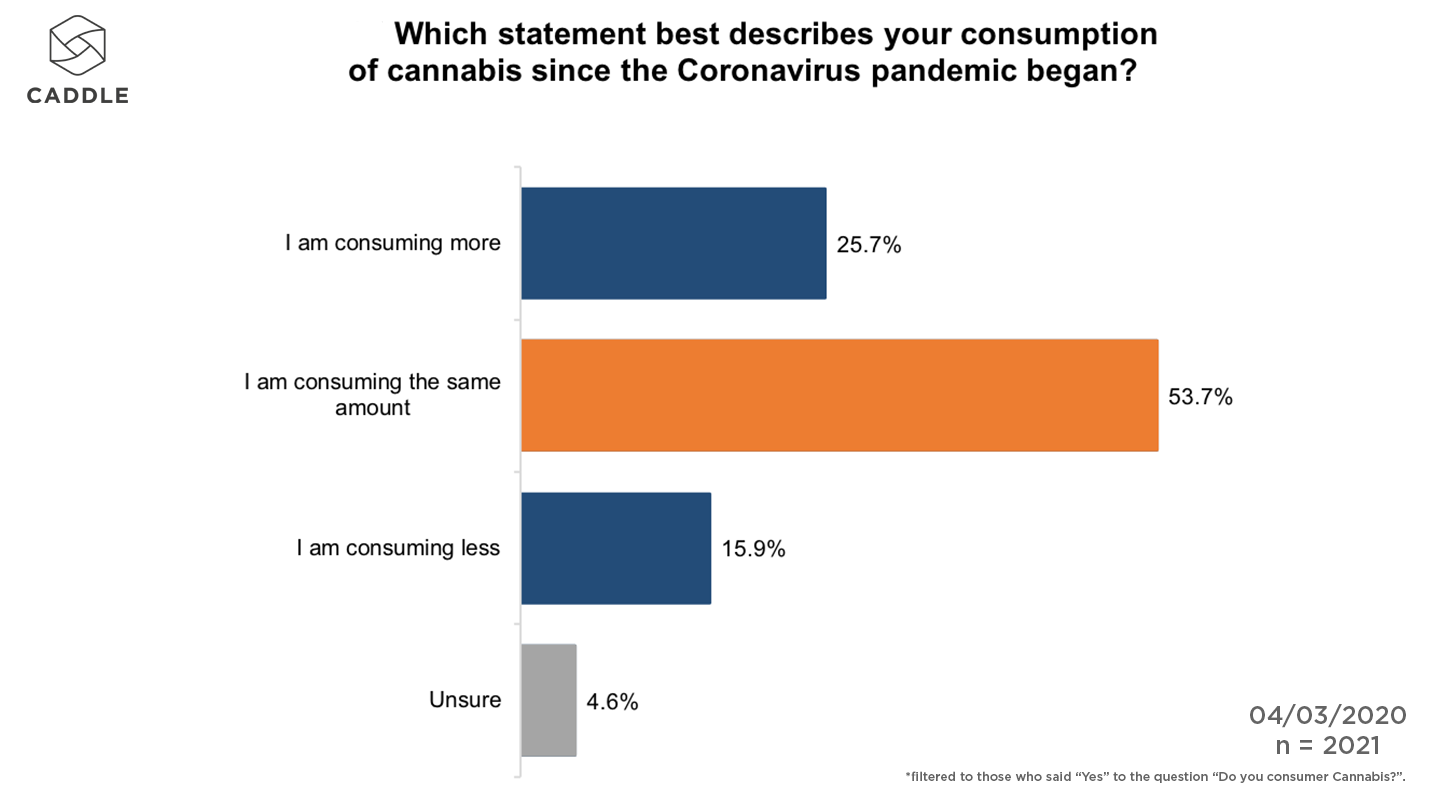
What we have is a picture where almost 80% of users have either maintained or increased their consumption since the pandemic emerged.
Does this mean a shift to online?
Over half of the panel (52.3%) said they were now more likely to buy online compared to before the pandemic was declared.
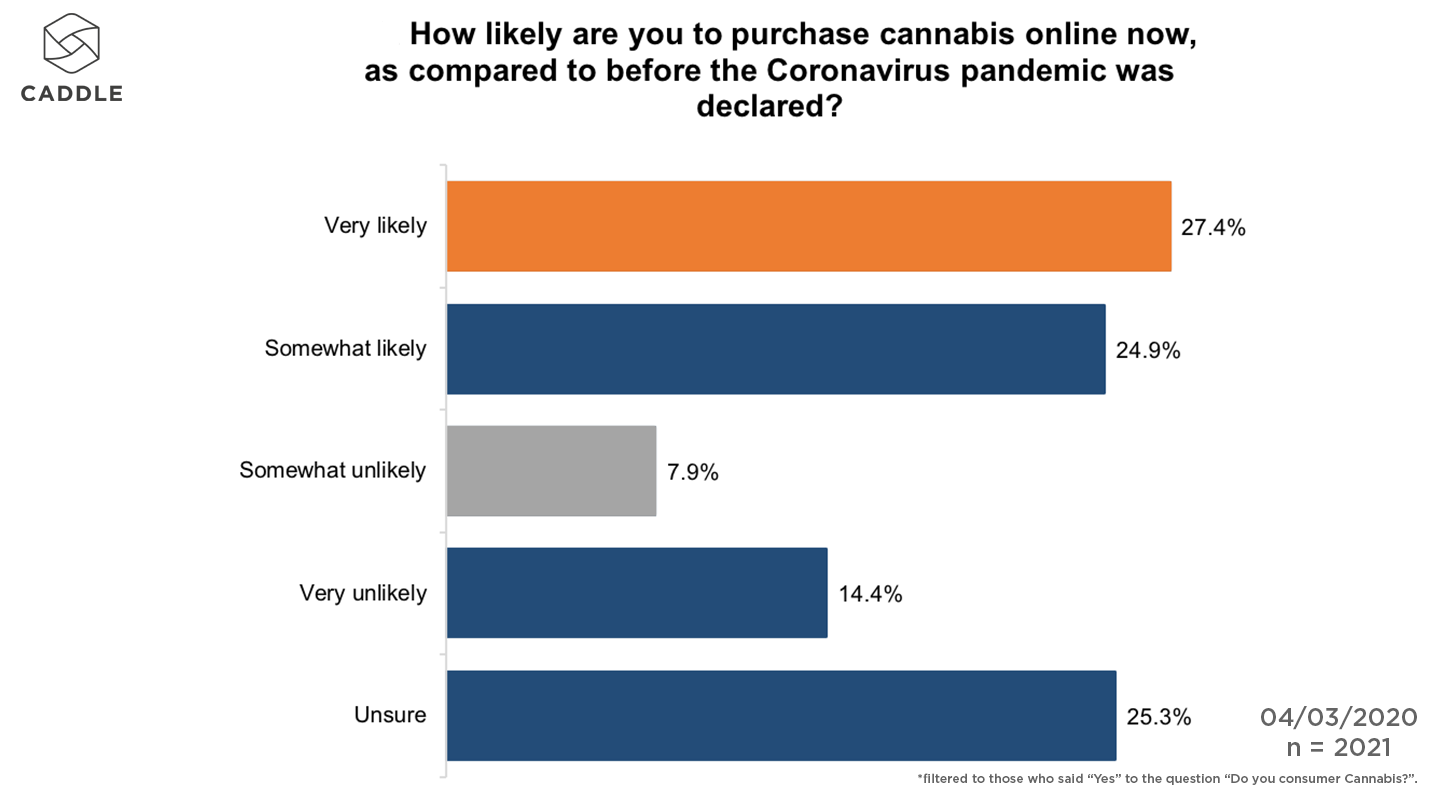
This trend holds across almost all groups. Gen Z, Millennial, and Gen X cannabis users said they were likely to try online, while the equivalent figure for Baby Boomers was 41%.
Ontarians were the most open to buying online with 55% reporting they were likely to buy online – compared to 45% in British Columbia.
The data does not distinguish between ordering online for delivery or to collect in person. However the big picture maintains the COVID-19 pandemic has potentially reduced the size market, with only about half of users considering making the switch to online purchase.
Which users are most likely to buy online?
Segmenting the users by their responses around online purchase we can group them into three distinct groups, distinguished by their consumption habits and demographic profile.
Segmenting the users by their responses around online purchase we can group them into three distinct groups, distinguished by their consumption habits and demographic profile.
Group 1 – Increasing cannabis usage, very likely to order online: Over-indexes on millennials Joints and edibles most popular means of consumption but over-indexes on bongs
Group 2 – Maintaining or Increase usage, somewhat likely to order online: Edibles and joints most popular , but under-indexes on smoking joints, over-indexes on bongs and vaping. No age skew relative to Cannabis users on Caddle panel.
Group 3- Maintaining / decreasing usage, unlikely to order online. Over-indexes on Generation X/Baby Boomer. Over-indexes on joints as preferred means of consumption.
Breaking the data down this way it’s clear that brand should be prioritizing Group 1 users in the current climate, since these users are increasing consumption and are most open to buying online.
Will Canadians switch to homegrown Cannabis?
With visiting retail stores less of an option, the other alternative to order online is growing at home. However this does not appear to be widespread across cannabis users on the Caddle panel.
While 34% said they were likely to try growing their own Cannabis, 46% said they were unlikely.
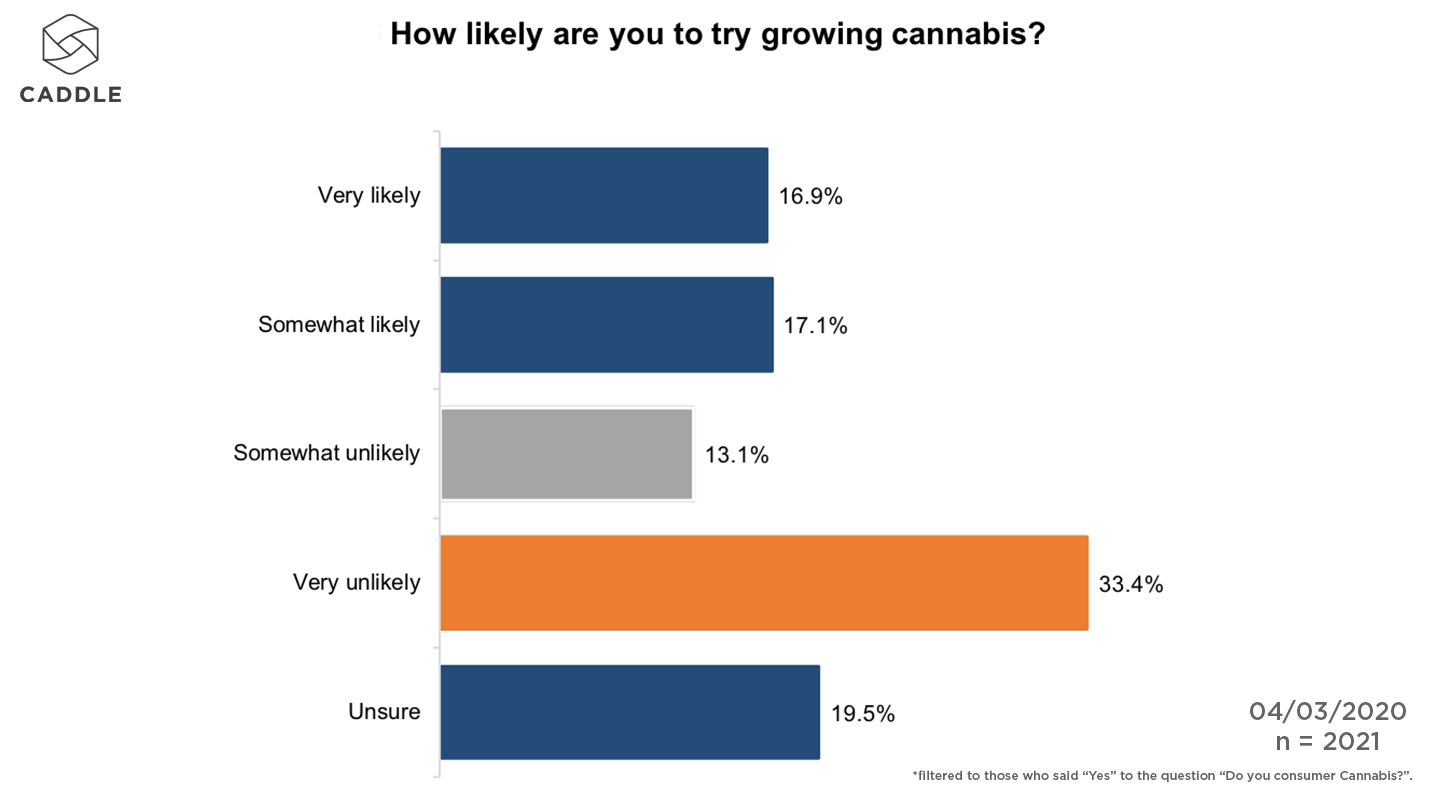
Ordering online and growing at home do not appear to be mutually exclusive. Those who indicated they were likely to increase online ordering were also the segment most likely to try growing themselves. Of the users in ‘Group 1’, 44% said they were likely to grow their own cannabis.
Key Takeaways
COVID Disruption has shrunk the market
Seeing half of cannabis users say they are likely to purchase more online due to the impact of coronavirus is striking.
But given the lack of official alternatives right now, this suggests that a significant proportion of users are either ceasing purchase, or purchasing outside of the licensed store system.
Focus must be on top users
Now more than ever Cannabis brands need to focus on the segment that is reporting higher usage. Brands need to work to understand the needs of this segment and target their campaigns and offerings accordingly.
Changes more likely to be temporary
Online ordering for Cannabis is less accessible than in other spaces such as groceries. We know that half of those ordering groceries online due to the pandemic will switch back after the pandemic. Given the extra restrictions around online ordering in the cannabis industry, the figure will likely be higher in this space.
COVID-19 Insights: How Canadians are cutting spending
-40% looking to reduce luxury purchases
That the economic shock caused by the COVID-19 pandemic would have major implications for consumer spending is clear. Caddle data shows as few as 15% of Canadians feel they won’t need to reduce spending.
What is less obvious, however, is how spending will change. What tactics will Canadians use to save money? Are we postponing purchases until after the pandemic, and if so, when do we expect to make them?
We put these issues to Caddle’s unique 10,000 member daily survey panel to understand how the crisis is changing Canadian spending habits. So, what did we learn?
How many people are cutting spending?
According to Caddle data almost nine in ten Canadians have cut back spending during the pandemic. Just over 85% told us the economic conditions had caused them to cut back expenditure.
Unsurprisingly, a large proportion of those who are cutting back spending cited a direct economic reason. A quarter reported that their income was lower, while 18% said they were reducing spending as a result of a business closing.
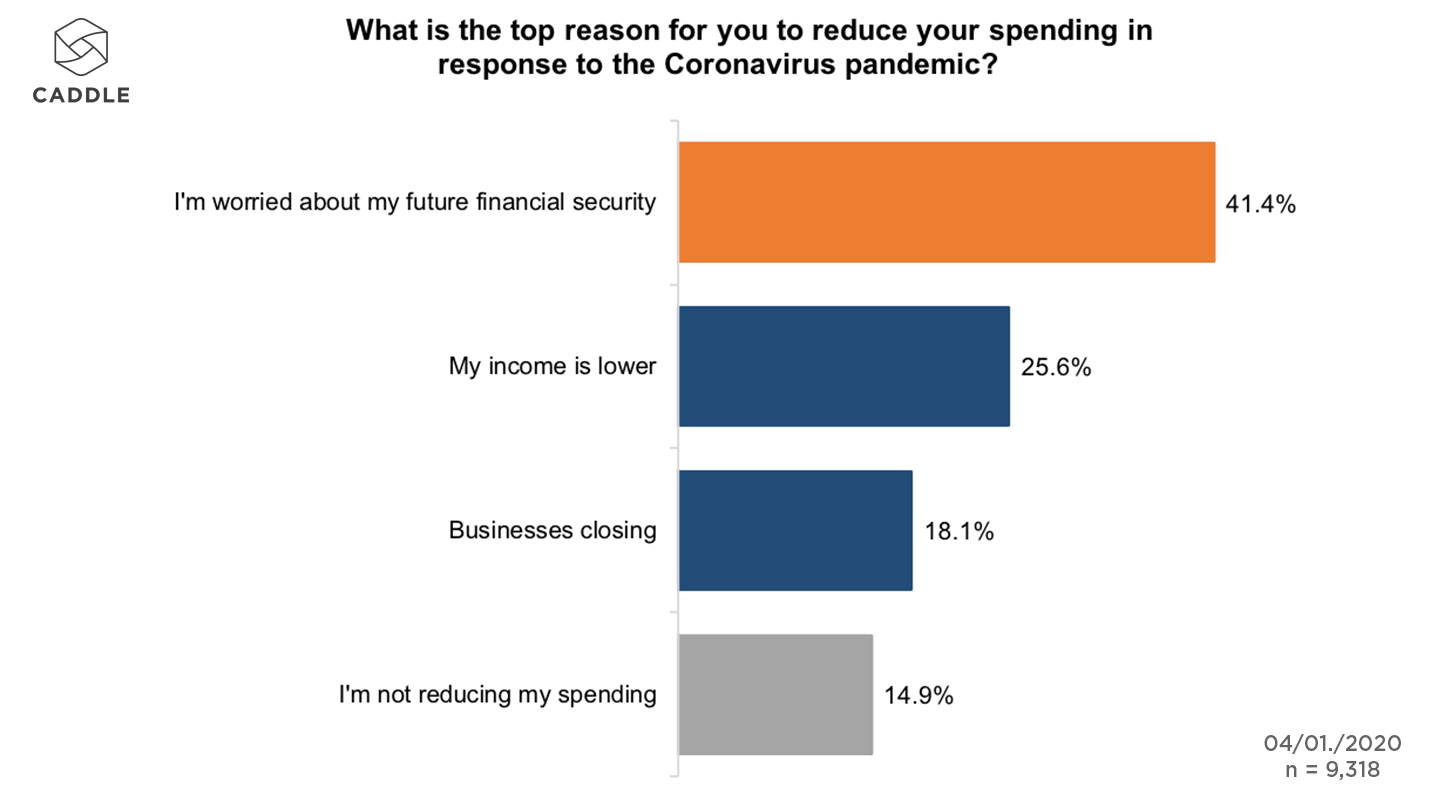
However, almost as many people again are holding back expenditure due to overall uncertainty. Just over 40% of our panel cited concerns about their future financial position as a reason to put off spending today.
How are we cutting spending?
What will be the most popular money-saving tactic among Canadians? Across all age groups, cutting back on luxury purchases is seen as the best way to save money, followed by more actively looking for sales and discounts.
Meanwhile, a much smaller proportion of the panel told us they see switching to cheaper brands or stores as the best way to save money.
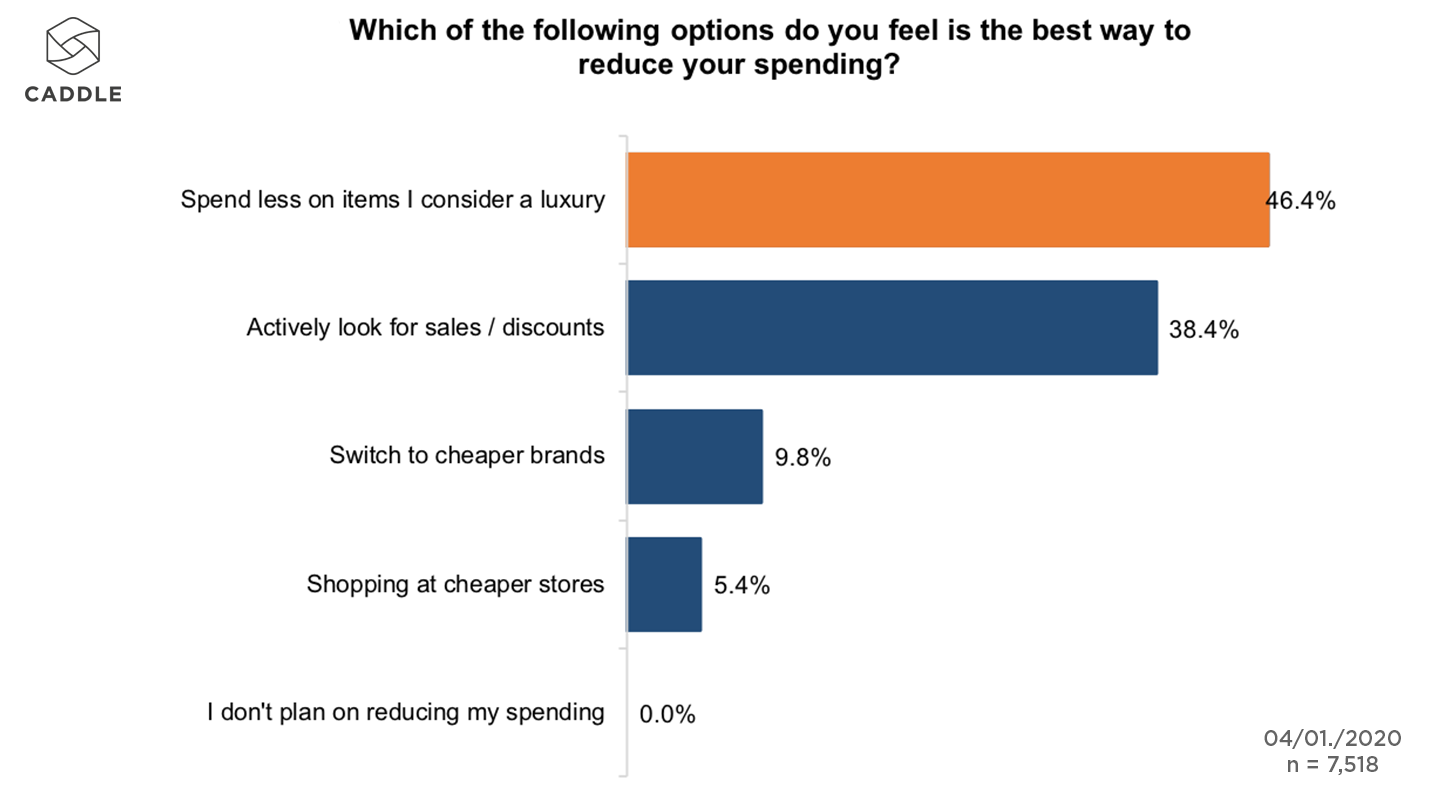
This data is significant for several reasons. Most noticeably, it informs the strategies Canadians see as most likely to use to save them money. It points to a big hit in discretionary spending by a large proportion of Canadians. With tighter budgets, luxury items are the first things to go.
Also significant is how few Canadians consider switching brands as the best option to save money.
In last week’s report we highlighted how one in five Canadians were prepared to switch grocery stores if their preferred brand failed to adequately enforce social distancing. However only 5% of our panel would consider switching stores as a top way to save money.
Likewise only 9.8% of our panel said they would switch to less expensive brands to save money. Yet in a study a few weeks earlier this month, 76% said a brand playing an active part in the COVID-19 response would affect their purchase decision.
This paints a complex picture of the impact of COVID on brand loyalty. Firstly consumers are more likely to reduce or cut out purchases entirely rather than switching to lower cost brands.
But beyond this, customers can be won or lost on action taken in response to COVID-19, rather than household economics.
How are different generations responding?
Breaking the preferred money-saving tactics down by generation reveals how different age groups respond to financial challenges.
The bonds of brand loyalty seem to be weakest for Canadians in Generation Z. Almost a quarter of those born after 1995 preferred switching to cheaper brands or cheaper stores as the way to save money. This compares with approximately 15% for the panel as a whole.
Meanwhile at the other end of the age spectrum, Baby Boomers were the only generation who did not choose cutting back on luxury purchases as the top way to save money. Instead, 46% said they would more actively look for discounts, compared to 38% for the panel as a whole.
‘Treat’ spending isn’t dead
The general preference for cutting back on luxury purchases does not mean we will completely cut back on things we consider treats. In fact, these types of purchases have a role in keeping our spirits up.
Excluding those who told us they were not cutting spending at all, a third of the panel said they had purchased a treat or a luxury item to keep their spirits up.

Interestingly, those who cited cutting back on luxury items as their preferred way to save money, were more likely to report making a luxury purchase to raise their spirits.
This suggests another complex relationship between consumers and the brands they buy.
For example, people who make the most luxury purchases may also be the people who have the most scope to save by cutting down on these items.
If such purchases also represent normality or better times for this group, it would make sense that they would also serve the purpose of a treat, reward or morale-boosting purchase during a challenging period.
Are we putting off purchases?
With a significant proportion of the panel cutting spending due to future concerns rather than direct economic impact, does this translate into purchases that could be made today being postponed?
Approximately two thirds of Canadians say they are putting off purchases due to the uncertainty around the pandemic.

There was little consensus around when the panel expects to be able to make these purchases. About 60% of those postponing a purchase expect to make in the next three months, but almost a quarter said they would postpone by over four months.
Key Takeaways
We’re cutting luxuries but will still treat ourselves
The first tactic many Canadians will adopt to save money is reduce luxury items. While undoubtedly a challenge for brands in this space, there is opportunity in tapping into the ideas of occasional morale-boosting treats.
Brand loyalty > Cutting Spending
The disruption caused by the COVID-19 isn’t necessarily interfering with traditional brand preferences. Only a small proportion of Canadians will abandon their usual purchase choices as their primary tactic for saving money.
Return to spending will be cautious
As we saw in our data on restaurant habits, a return to ‘normality’ for spending may be tentative once restrictions begin to be lifted. Relatively few consumers will go back to their old spending habits overnight.
COVID-19 Insights: How consumers pick their grocery store
Almost 50% would switch stores over inadequate social distancing
The importance of winning over grocery shoppers has arguably never been higher.
Consumers are making fewer trips to a smaller list of stores and a fifth of them are prepared to switch from their regular store.
So what determines which grocery store Canadian customers choose to visit, and what factors are breaking the bonds of brand loyalty?
Caddle turned to our daily panel of 10,000 Canadian consumers to find out.
Social distancing really matters
To Canadians visiting physical locations, part of the in-store experience has become more crucial than ever to where they choose to buy groceries.
Right now that means rigorous enforcement of social distancing policies. So much so, in fact, that a significant proportion of Canadians would abandon their preferred grocery store if they were not comfortable with the social distancing measures taken.

Almost half (48.4%) of the panel said they would switch stores if their store was not enforcing social distancing policies.
Product availability remains key
While grocery chains have been able to replenish shelves after the initial burst of panic buying, product availability remains the driver of grocery store choice.
When we asked the Caddle panel on March 30th what determined which store they would visit, 33.4% cited product availability.
However this was around the time of frequent media coverage about empty shelves and panic buying. Have priorities changed in recent weeks? In a word, no.
Product availability remains the big decision maker. We asked the panel on April 12 and 43.4% said product availability was most important, although to a slightly differently worded question.

Nevertheless the picture is the same, availability matters more than competitive prices, or store location.
Is click and collect an alternative?
Compared to shopping in store, click and collect services are less popular – even during the current pandemic.
When looking specifically at panel members who had used click and collect services, 38% said they preferred in-store purchasing, compared to 28% who said they preferred ordering online and collecting.
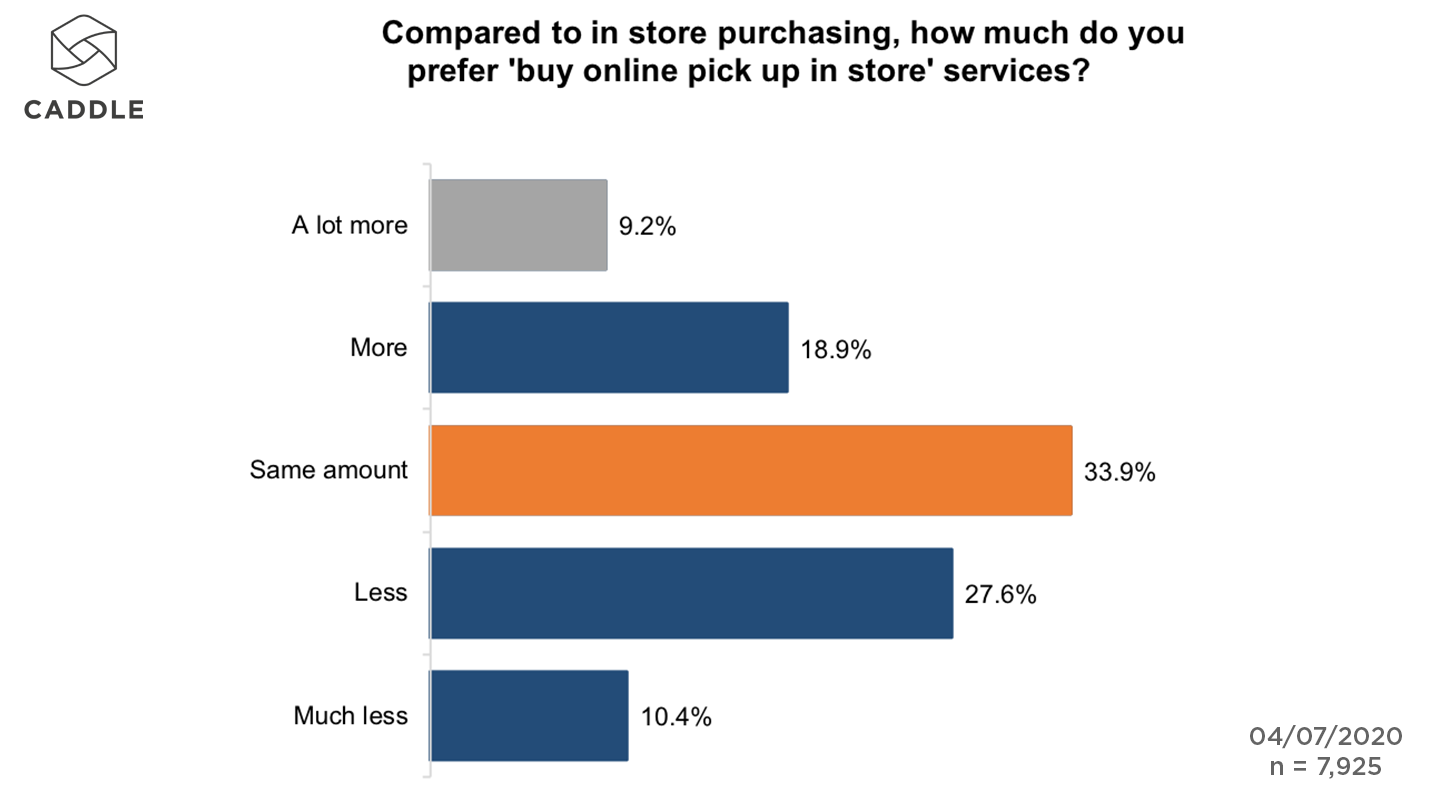
Gen Z are the most open to click and collect. With 31% preferring it to instore, and 33% opting for the traditional in-store experience.
Baby Boomers are the least receptive with nearly 60% saying it is less preferable to buying in store.
This matters now in particular given the efforts chains are making to ensure access to grocery stores for older Canadians such as opening early or designating specific hours for seniors.
Based on this data at least, ordering ahead online will not play a part in creating more opportunity for older Canadians to buy groceries.
What is putting people off click and collect?
We asked the panel what they felt were the biggest obstacles with click and collect. The responses suggest consumers miss the choice, as well as the ability to easily browse the wide array of goods.
Panel members told us that selection and appearance of the product were the two biggest obstacles, followed by the time to prepare the order.
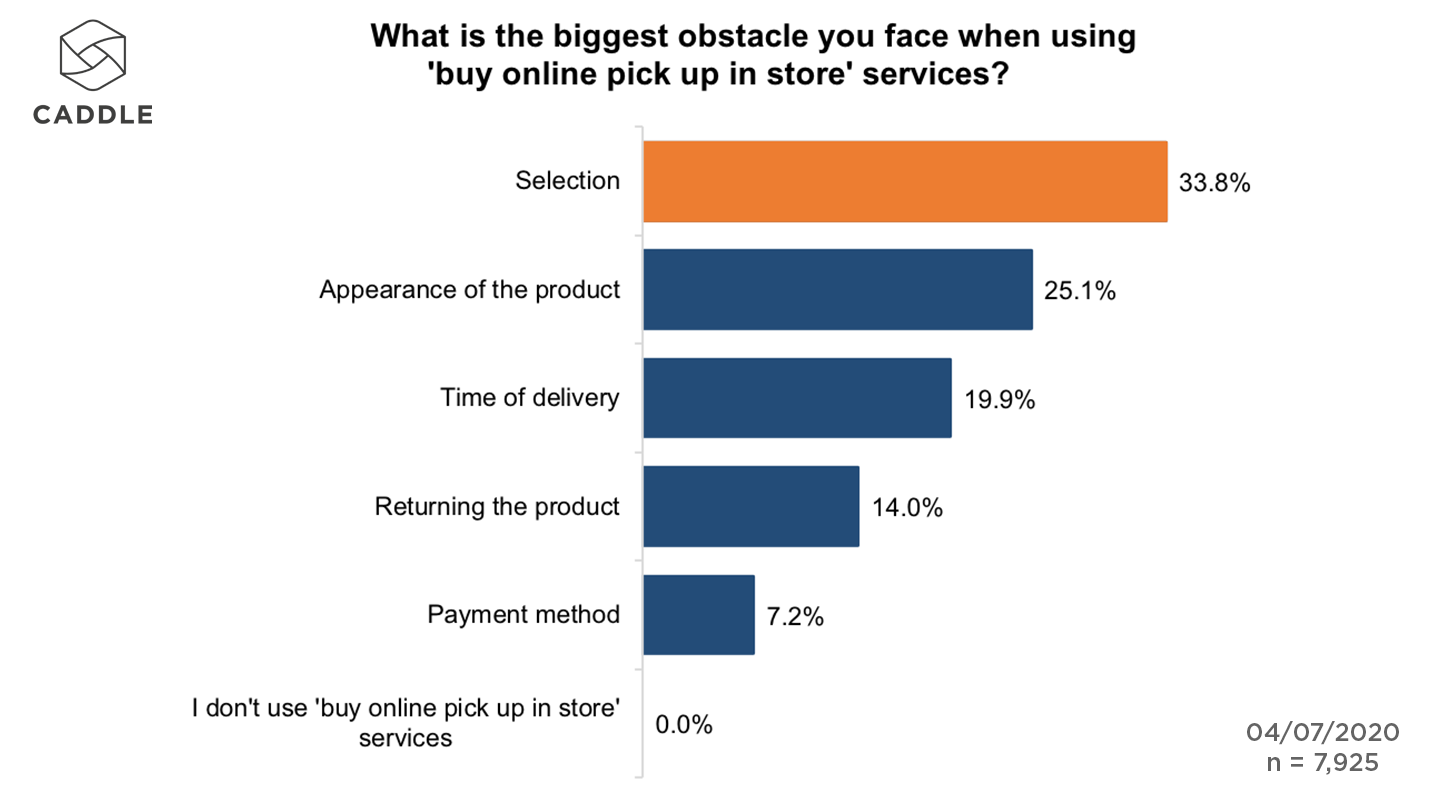
Alongside these obstacles are concerns about cost and complexity. Asked which word they associated most with the click and collect programs, 15.5% chose ‘complex’.
A further 14% selected ‘expensive’, which is surprising given the relatively modest fees charged for collection. If not related to service fees, this suggests wider concern about either higher prices online generally, or the ability to browse for savings on an online platform.
Is this a messaging issue?
Alongside the perceptions of cost or complexity, part of the reason there hasn’t been a wider take up of click and collect type services is a lack of awareness.
We asked the panel where they had heard about such services. Looking only at the respondents that told use they had never used click and collect 25% said they had never seen any messaging about click and collect services.
Key takeaways
Social distancing is crucial to in-store experience
Now really is the time for grocery stores to show how seriously they take social distancing. The data here suggests that customers will reward the stores that make this the focus of in-store experience — so long as they keep their shelves stocked.
Click & Collect isn’t first choice experience
Consumers still prefer the in-store experience. If stores want to encourage more customers to use click and collect services — whether during the pandemic or after — customers needs to be convinced with a better experience.
This means finding ways to improve the online browsing experience through better selection or product visibility, and minimizing any unnecessary complexity.
Grocery pickup services need sharper comms
Given that a quarter of those who hadn’t used click and collect weren’t aware of it, any push to increase usage of click and collect needs a stronger push on messaging. This could also go some way to countering the perception of the service as ‘complex’ or ‘expensive’.
What will get restaurant customers to return after the pandemic?
The devastating impact of the COVID-19 pandemic on the Canadian restaurant industry is plain to see. In March 2020 alone, the sector lost an estimated 800,000 jobs.
Things aren’t going to get easier anytime soon. According to Caddle data, just 16.9% of Canadians plan to resume dining out right away after restrictions are lifted.
What can brands do to win back the customers? This was what Caddle looked at in partnership with Cult Collective.
Based on data from our panel, there’s some good news for restaurants. Most customers eventually plan to get back to their old habits once the crisis passes. However this will be with slightly altered priorities of what they look for in an eatery — ones centred on cleanliness and service.
Pre-pandemic: How did consumers choose a restaurant?
To get a sense of the magnitude of the hit the restaurant industry took, consider how Canadians chose to order food before the pandemic.
The culture was much more centred around dine-in than takeout, leaving the industry much more exposed.
Before the crisis, most Canadians would visit restaurants more than they would order takeout. Just over 63% said they dined out at least once a month, while the equivalent figure for takeout was just over 40%.
What impact did coronavirus have?
With all restaurants closed to dine-in customers, the business from the more than 60% of Canadians who went to restaurants at least a few times a month was gone.
But it did not translate into more takeout orders. More than 80% of Canadians either maintained or reduced the amount of food they had delivered.
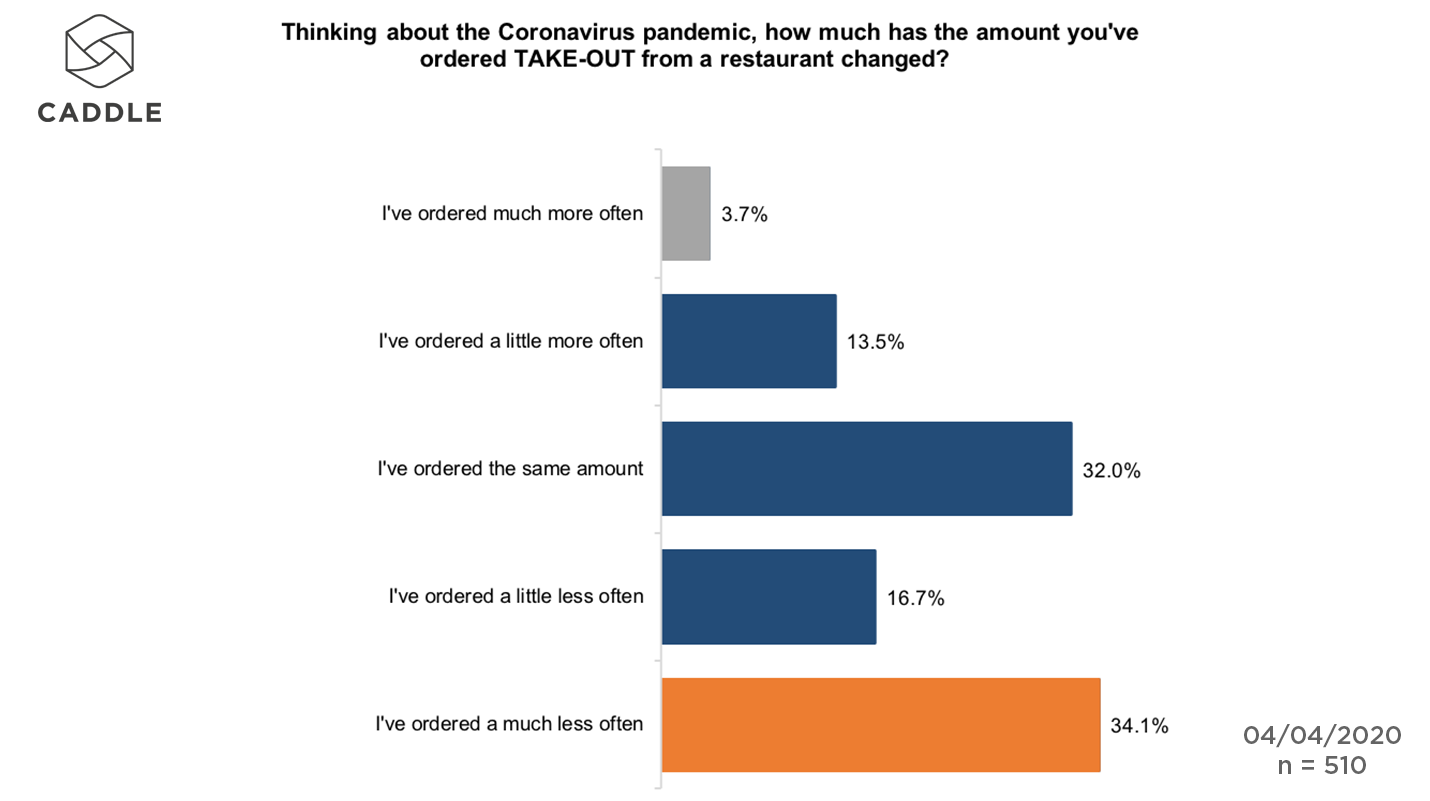
Consumers’ own economic concerns are restricting demand, but this is not the main reason Canadians gave for not ordering more takeout. Over 43% of respondents viewed “safety and cleanliness issues” as the biggest barrier to ordering takeout and delivery.
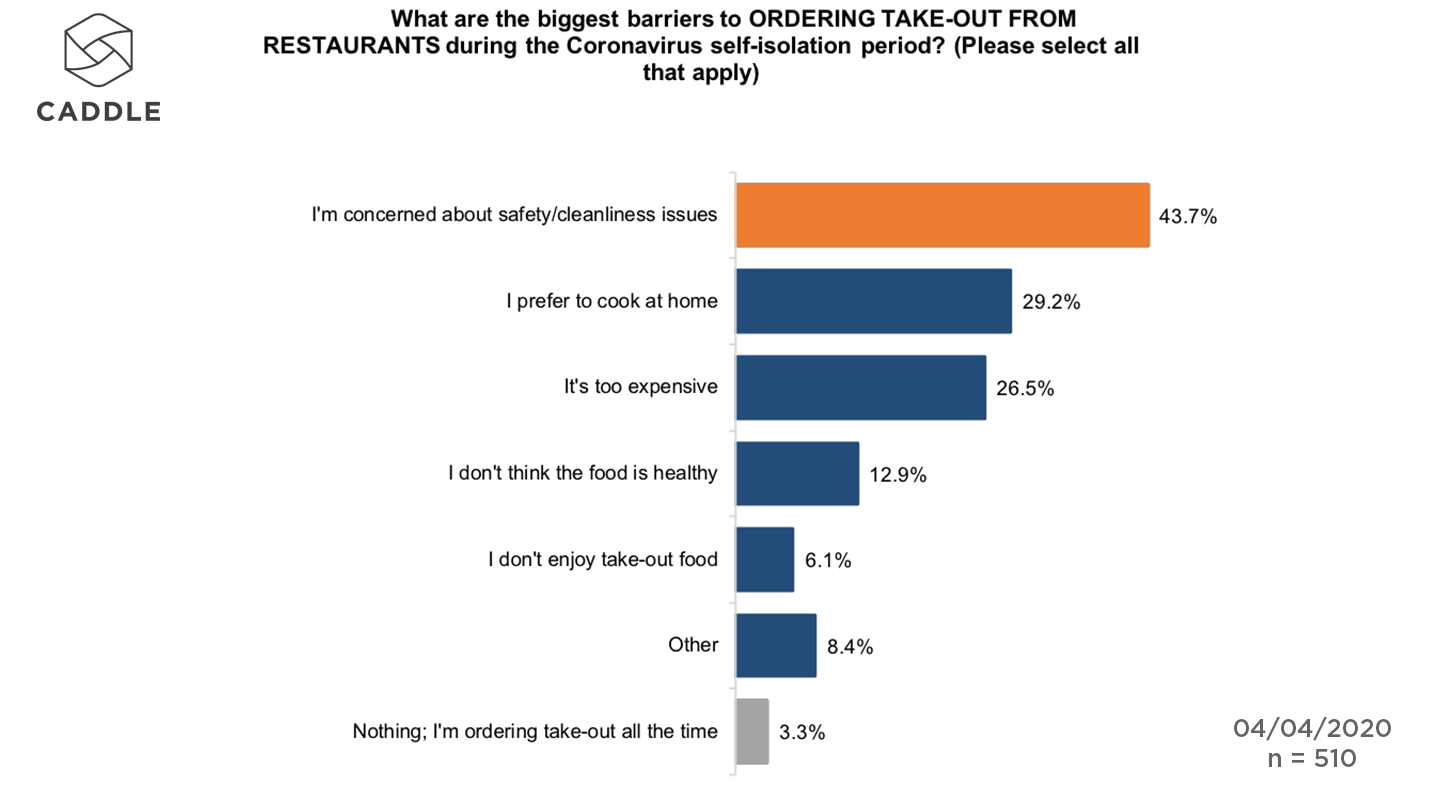
Will things go back to normal?
When restaurants are able to open again, the resumption of consumer habits will not be immediate. Just 16.9% of consumers say they will resume their old dine-in restaurant habits right away, with 17.6% saying the same for takeout options.
After two months, 60% of people anticipate they will have returned to their old habits for both takeout and dine-in food.

However, 22% say they expect they will continue visiting restaurants on a long term basis, with 33% saying the same for takeout.
How to win customers over?
When restaurants reopen, they will be competing over a smaller pool of diners. Winning over customers will be crucial. How can businesses get an edge? Cleanliness, service and experience.
For both trying a new restaurant and returning to a restaurant, cleanliness and friendliness were chosen as the top options.
What does this mean?
So what should restaurants make of this data? Brandon Poole, Managing Director, Cult Collective Toronto, says it shows how important tracking customer experience will be to the recovery of restaurants.
“This data shows that, increasingly, restaurants will need a formal and robust CX data strategy. Brands without formal tracking of customer motivations, intent and behaviours prior to the COVID-19 crisis will have the most difficult path to recovery.”
“Restaurant brands must plan for a long-term focus on food experience, customer experience, and restaurant/service environment as they rebuild and reinvent their brand.”
“Restaurant brands are digital brands now. They will be better prepared for and insulated against severe socio economic crises if we formally build in digital transformation strategies to increase engagement, purchase intent and affinity through the customer journey.”
COVID-19 Insights: Surge in Grocery Delivery Likely Short Term
25% ordering more online than before pandemic
The impact of the COVID-19 pandemic should mean a big boost to online grocery delivery.
The reported struggles of consumers to book time slots for deliveries suggest a major increase in online grocery purchase.
However this week’s COVID-19 Rapid Response report suggests that the pandemic is impacting how we buy groceries in more ways than a simple shift to online ordering.
On the evidence from Caddle’s 10,000 daily survey responders, Canadians are switching to different grocery stores as well as ordering more online.
If you’re not already on the mailing list, sign up for our free weekly summary here.
Are we buying more online?
According to our research, about 1 in 4 of us are ordering more groceries online than we did pre-pandemic, while 13.4% of our panel tried grocery delivery service for the first time.
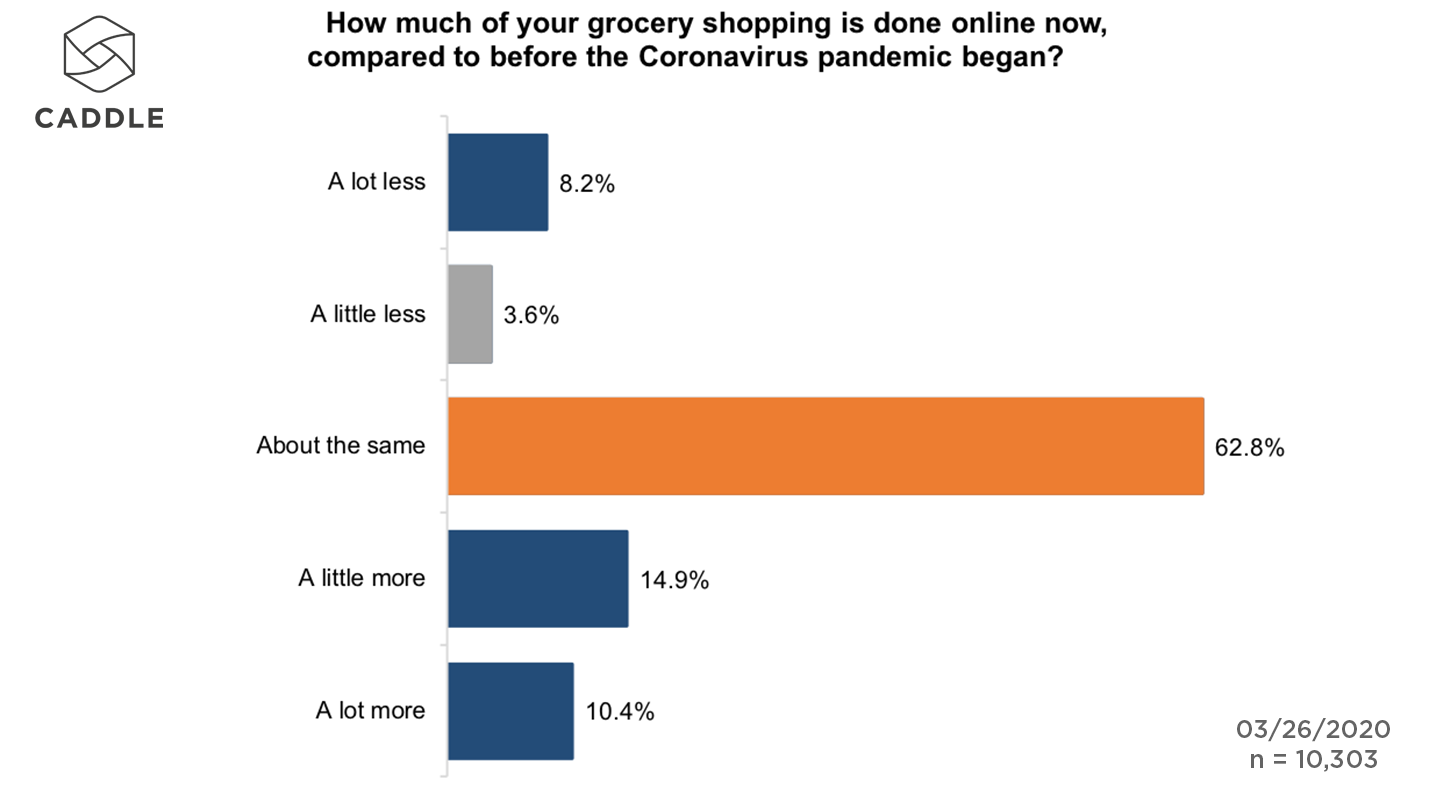
Similarly, 22% expected that they would use an online grocery service in the next month.
For changes that took place in a matter of weeks, that’s a relative big shift in use — which would explain stories about capacity issues.
But will the surge last?
Is this a permanent shift to online grocery?
Not completely. How much of these new online shopping habits will keep up once the pandemic is over? Based on our panel responses, about half of them.
Of people who told us they were shopping for groceries online more since the start of the pandemic, 52% said they would continue at this level after the crisis.

Some of the new users will also be converted into long-term customers. 60% of the shoppers who told us they tried getting groceries delivered for the first time, said they anticipated they would use delivery services more at the end of 2020 than at the start.
So what will the net impact be? Just over 13% of people say they expect to use online grocery delivery more after the pandemic than at the start 2020. The figure tends to be higher for those with children under 18, who are also the primary shopper, suggesting a stronger overall impact.
What’s happened to in-store visits?
There is a more pronounced, albeit short-term change in how we shop at brick and more stores.
Since social distancing measures were implemented, going to the grocery store is something most Canadians do once a week at most.
Approximately 80% of our 10,000 daily panel say they shop weekly or less frequently, with 42% currently shopping less than once a week.
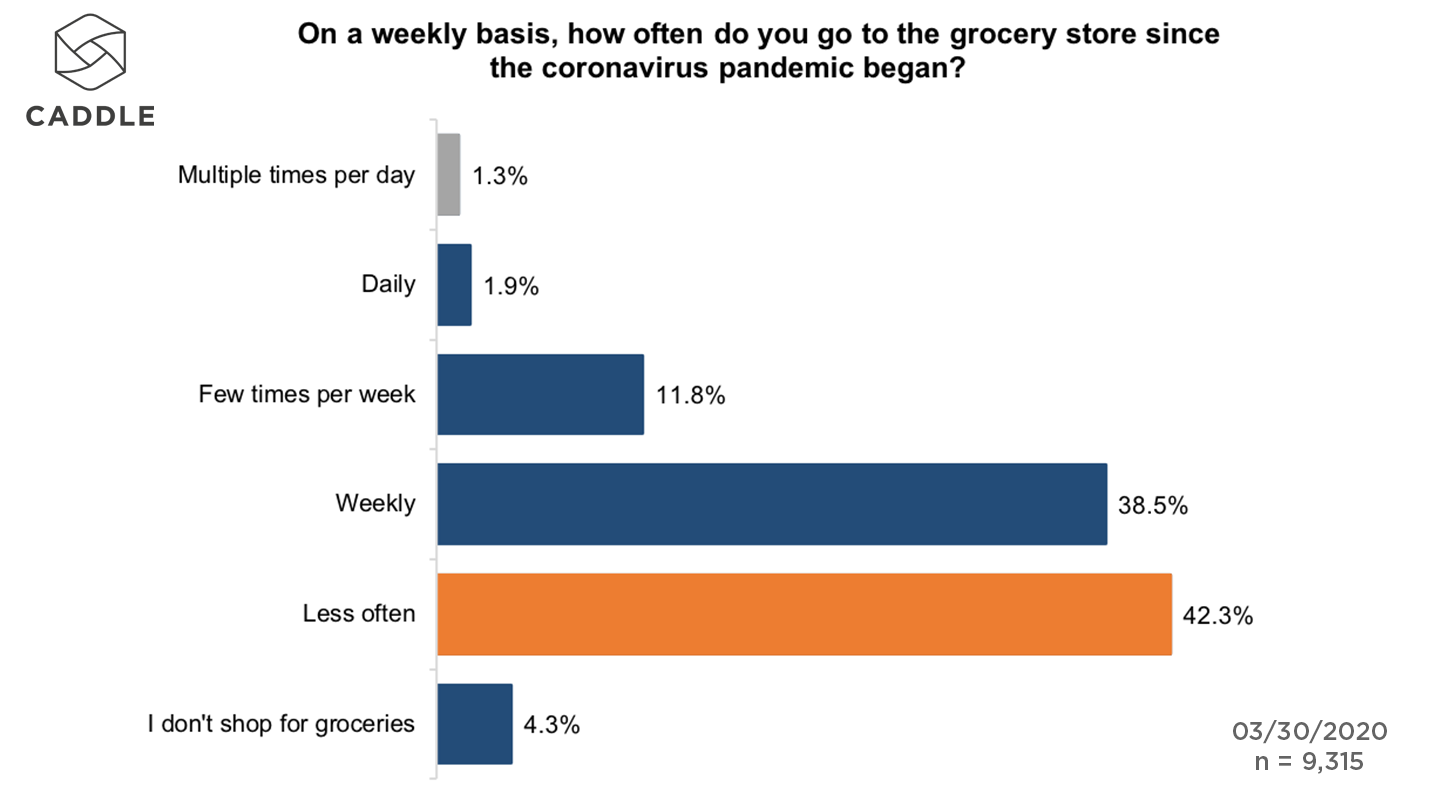
Not only are there less frequent store visits for stores to compete over, but shoppers are going to fewer stores on average. Just over 70% of our panel told us they went to fewer stores.
While we’re visiting less stores, we are willing to try different stores to our usual supermarket. Just over one in five of our panel said they had switched in the supermarket during the crisis.
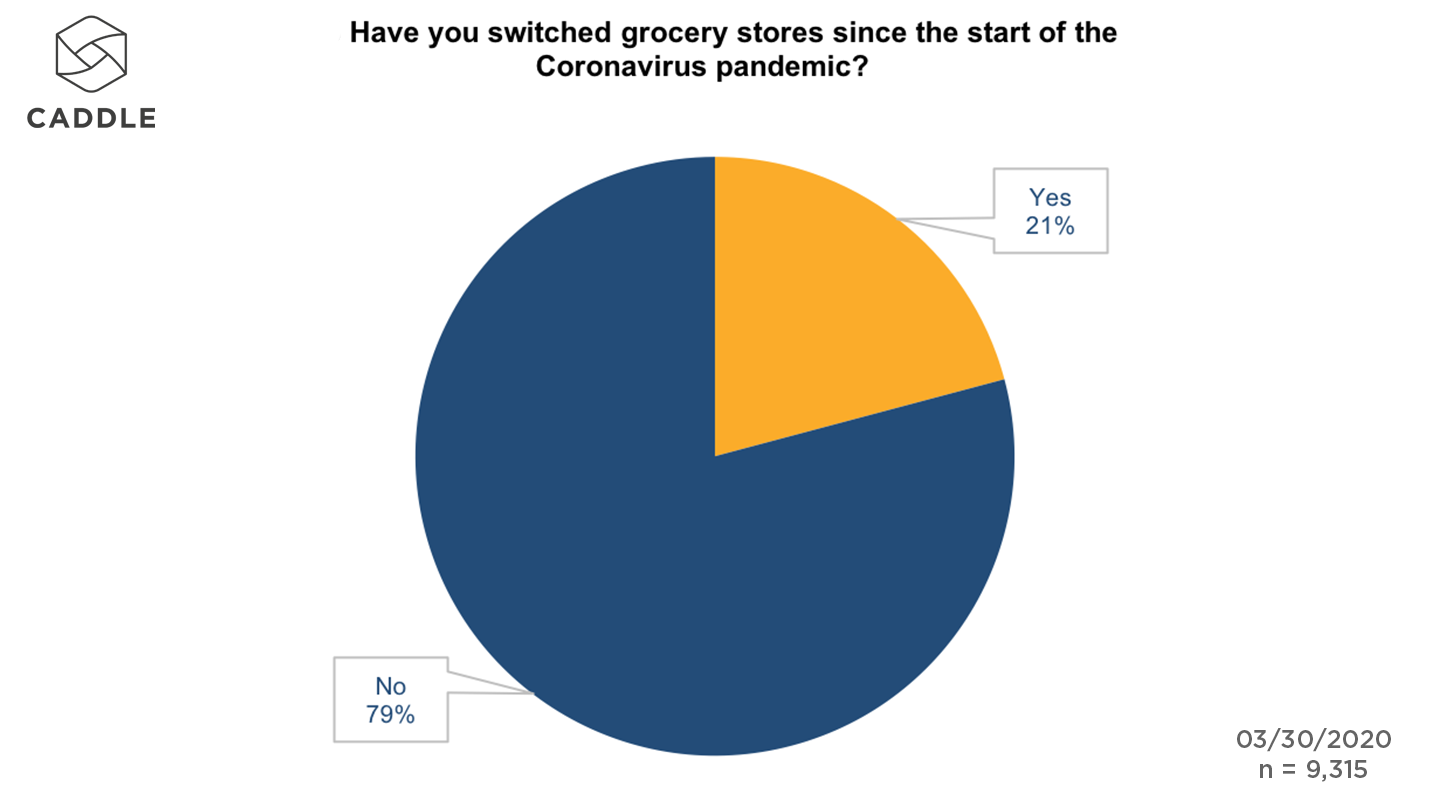
What was the biggest reason to switch supermarkets? Rather than price or proximity, shoppers were more likely to switch due to availability of products.
As well as stocking what people are looking for, strong enforcement of social distancing in-store would win over shoppers. From a list of precautions listed, panel members selected this as they one that would reassure them most.
Why we’re cutting out takeout
With restaurants already taking a hit due to enforced closures, operating exclusively as takeout or delivery-only businesses, Caddle’s data has more bad news for restaurants: Canadians are also reducing the amount of takeout we order.
Just 8.5% said they’d had food delivered in the last week, and 34% said they were ordering much less takeout than prior to the pandemic.
Given the uncertain economic situation, money was, unsurprisingly, a big reason people gave for ordering less takeout. But it isn’t the only reason.
Preference played a part too. 26.4% told us they just preferred having home cooked meals. Concerns over cleanliness, potentially due to the pandemic was the reason for 18% of people ordering less takeout.
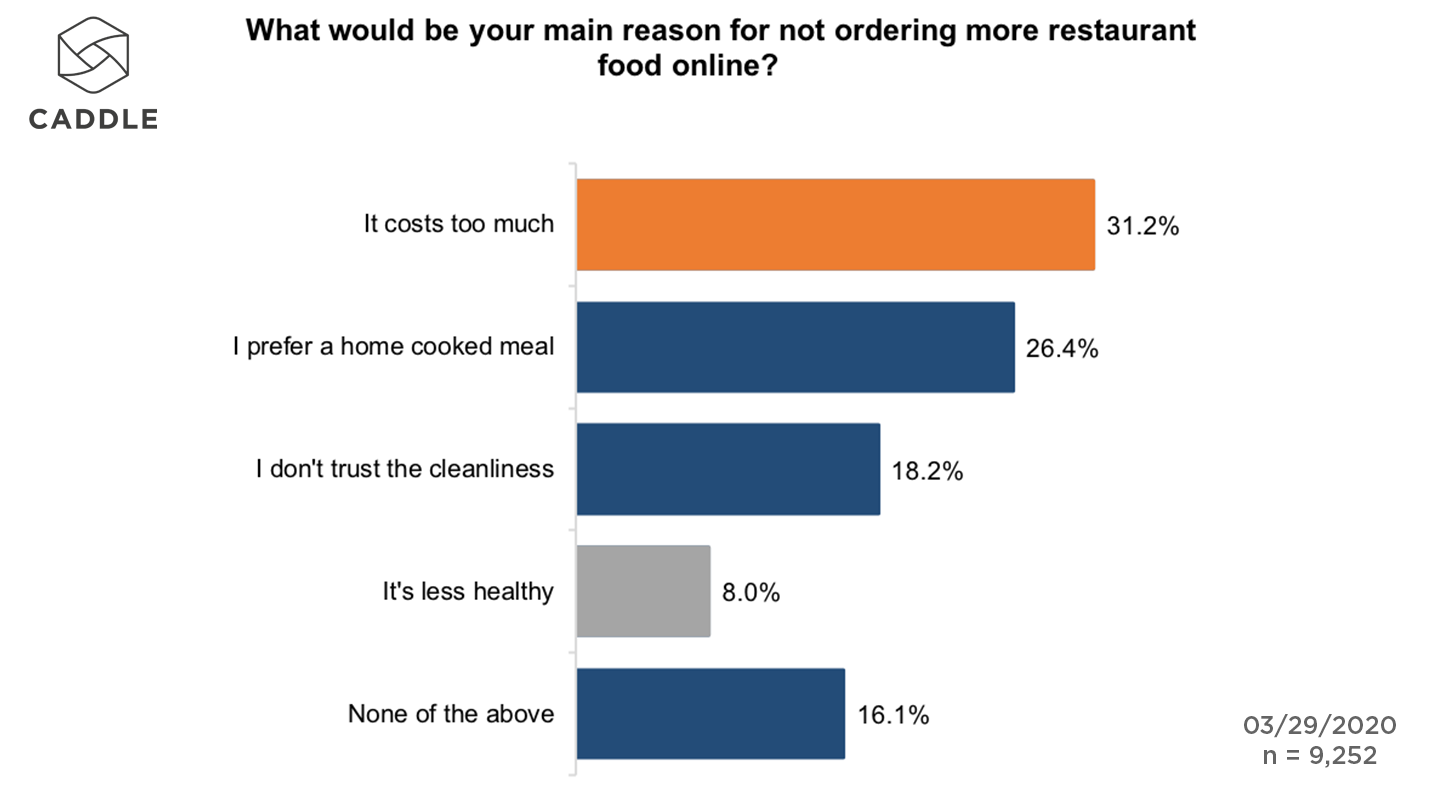
Support for local businesses
Despite the reduction in purchases from local restaurants, Canadians are very much alive to the problems being faced by local businesses — and they want to help. Despite their own economic hardships, they are doing what they can to support.
Just less than a third of the panel said they were buying more local goods and services compared to before the pandemic. 42% said they had made a purchase specifically to support a local business during the pandemic.

They also want to see other businesses doing what they can to support local producers. Almost three quarters of our panel told us they want to see grocery stores stocking more local goods to support businesses.
Key Takeaways
No mass switch to online grocery yet
As it stands only 1 in 8 of us think we’ll order more of our groceries online after pandemic than we did before.
First trial key to growing online grocery
Those who used it for the first time were much more likely to say they will use it more than prior to the pandemic. With little over 10% of the panel reporting they have tried for the first time, businesses should be doing all they can to encourage this first trial.
Competition for store visits hotting up
People are visiting fewer grocery stores and going less frequently – increasing competition between stores, to gain or retain customers – especially when 1 in 5 people have already switched stores.
Canadians Reject Roll Up The Rim Changes
40% say Tim Hortons contest worse this year
Just 11% of Canadians believe Tim Hortons’ recent changes to its Roll Up The Rim contest have improved the promotion.
That’s the verdict of Caddle’s 10,000 panel of daily survey responders.
With its restaurants only open for drive through and delivery due to the COVID-19 pandemic, Tim Hortons new, largely digital contest got a thumbs down from our panel.
Caddle members told us that they welcomed the improved sustainability from a shift away from paper cups. However, this was not a big enough issue to impact sentiment of the program overall.

Instead, we found that a key factor determining how Canadians feel about the new Roll Up The Rim process was simply whether they won a prize or not.
Get insights to your inbox: Join the Caddle mailing list here
What changed in Roll Up The Rim?
Initially, Tim Hortons had planned to make sustainability a bigger part of this year’s contest. The four-week campaign also would have split into two phases.
The first 14 days would see customers who purchased a beverage getting a chance to roll up a paper rim. The second half of the campaign would be digital only.
Alongside this, 1.8 million free reusable cups were to be distributed to launch the campaign, with customers getting an extra digital ‘roll’ for reusing their cup.
However in response to public health concerns from the coronavirus pandemic, Tim Hortons announced that the campaign became digital-only for its entirety.
Caddle surveyed the panel after the 2020 Roll Up The Rim Campaign launched. So these findings are a verdict on the campaign as it ran, not as it was initially proposed by Tim Hortons.
What did consumers make of Roll Up The Rim 2020?
Across our entire panel, just 11% felt that the changes improved the contest, with 40% saying this year’s Roll Up The Rim was worse than previous years.
For those who actually participated in this year’s contest, the picture was a little less negative.
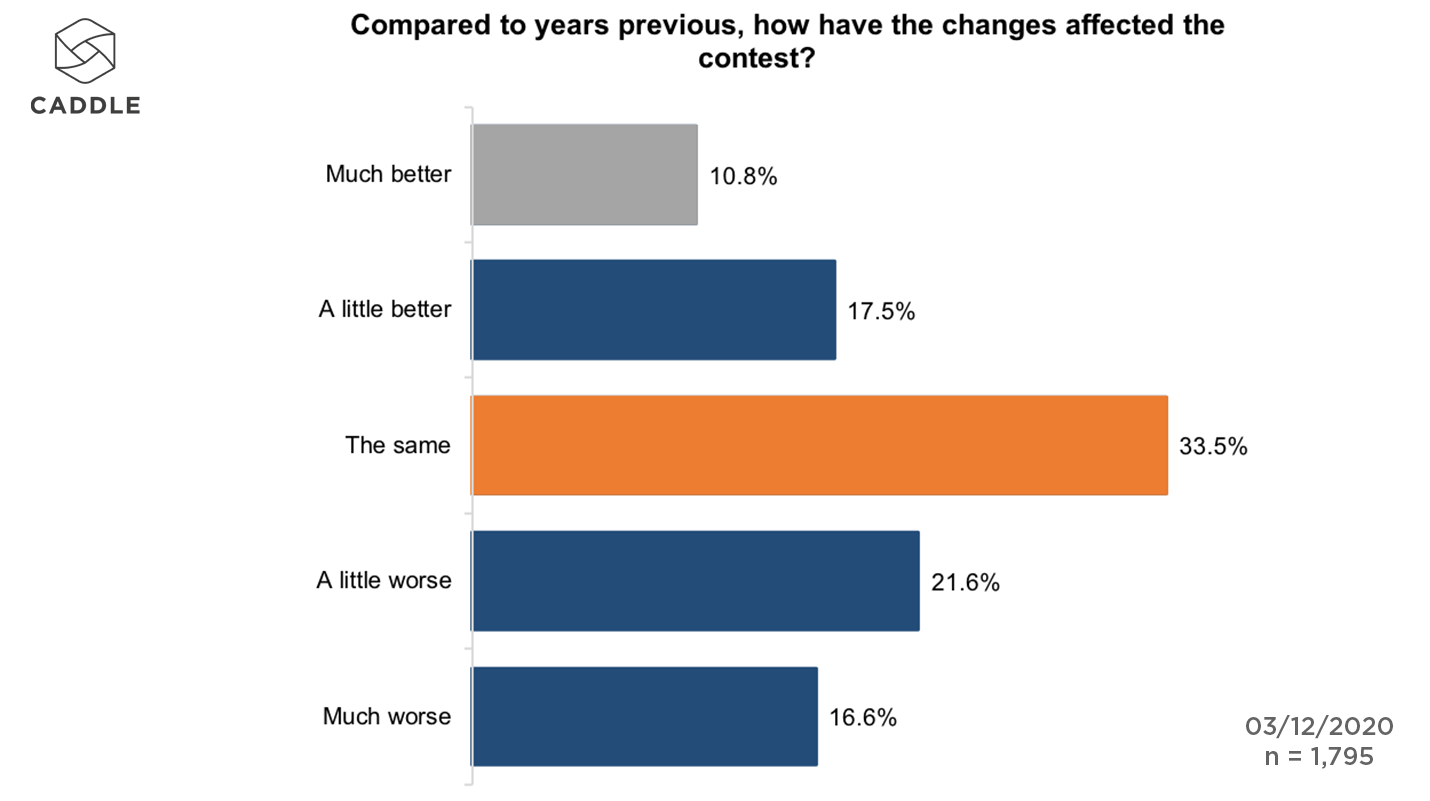
Over a quarter of panel members who had tried Roll Up The Rim told us this year’s version was better, compared to 38.2% who said it was worse.
This suggests at least part of the problem could be perception. Overall, Canadians held slightly more favourable opinions when they had participated in the new Roll Up The Rim format.
Which groups were most receptive?
Looking deeper into the demographics, men preferred the new Roll Up The Rim format more than women — especially when they had participated this year.
For all panel members, 13.8% of men preferred the contest compared to 42.4% who liked previous years better. For women, 9.4% enjoyed the changes compared to 46.3% who found it less appealing.
Among those who participated this year, the change is more marked. For Men, 37.4% preferred the 2020 format, while 27.6% liked it less. For women who played, the difference was 24.7% in favour compared to 41.2% against.
Our data also suggests that the changes appealed most to younger Canadians, rather than Tim Hortons’ traditionally older market. Meaning new format was potentially least popular with the groups most likely to go to Tim Hortons in the first place.
Including participants and non-participants, 15.8% of Gen Z Canadians preferred this year’s contest, compared to 10.3% of Millennials, 9.8% of those in Gen X and 8.9% of Baby Boomers.
Did the sustainability strategy work?
The good news for Tim Hortons is that the added sustainability of their 2020 campaign did break through with consumers.
Just over 45% of our panel said the new format improved environmental sustainability, compared to 40% who said it made no difference.
The problem Tim Hortons faces is that sustainability isn’t high on the list of things people look for in the contest.
Just 4% of the panel picked environmental sustainability as something they looked for in Roll Up The Rim — the lowest percentage for any of the options available.
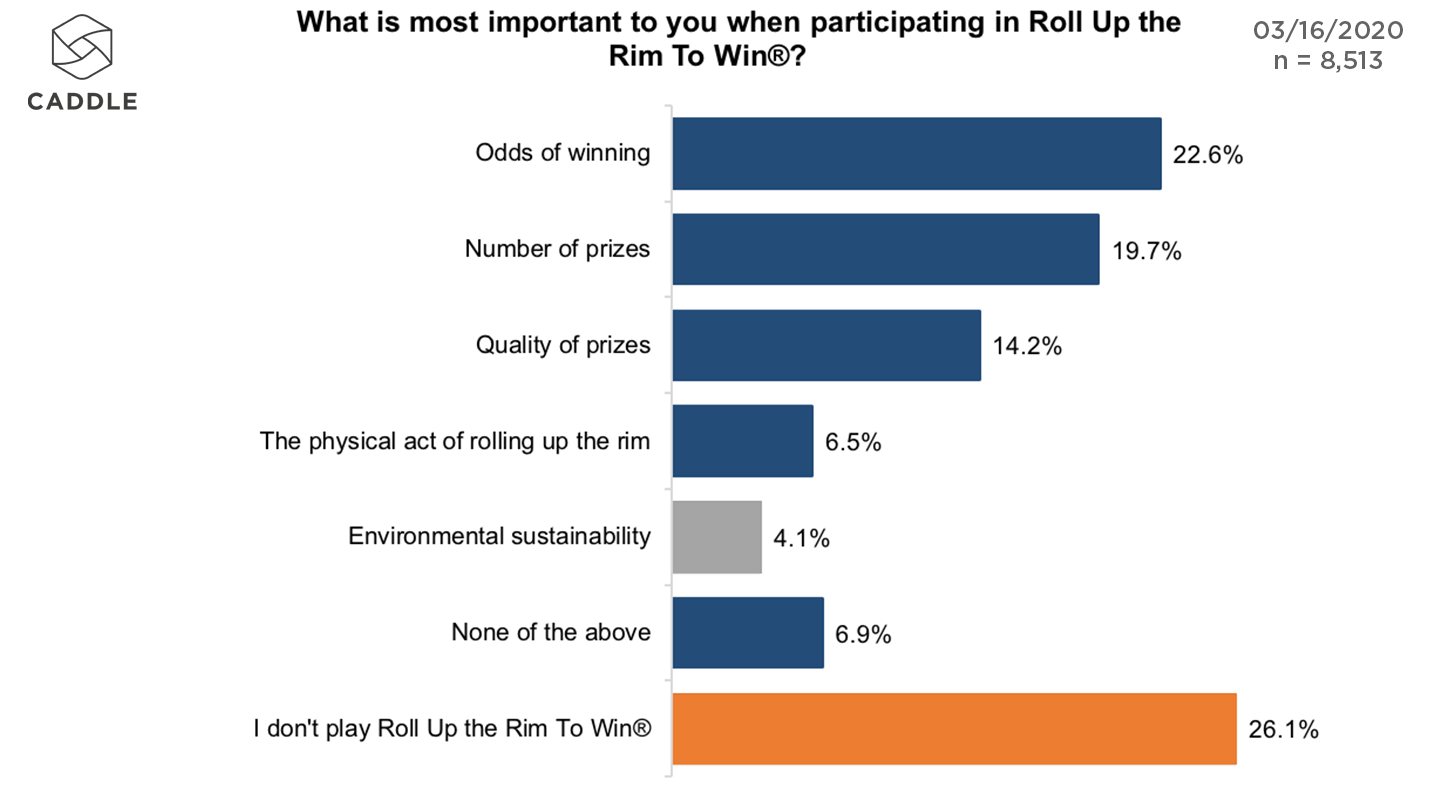
Far more important to customers were the odds of winning and the number of prizes, and other Caddle data underlines this point.
Winning is everything
Segmenting panel responses according to whether respondents won a prize or not, provided a useful insight.
Canadians who won a prize in the 2020 Roll Up the Rim contest, were markedly more positive about the contest.
44.1% of prizewinners said they preferred this year’s format, compared to 23.5% who preferred how the contest worked in previous years.
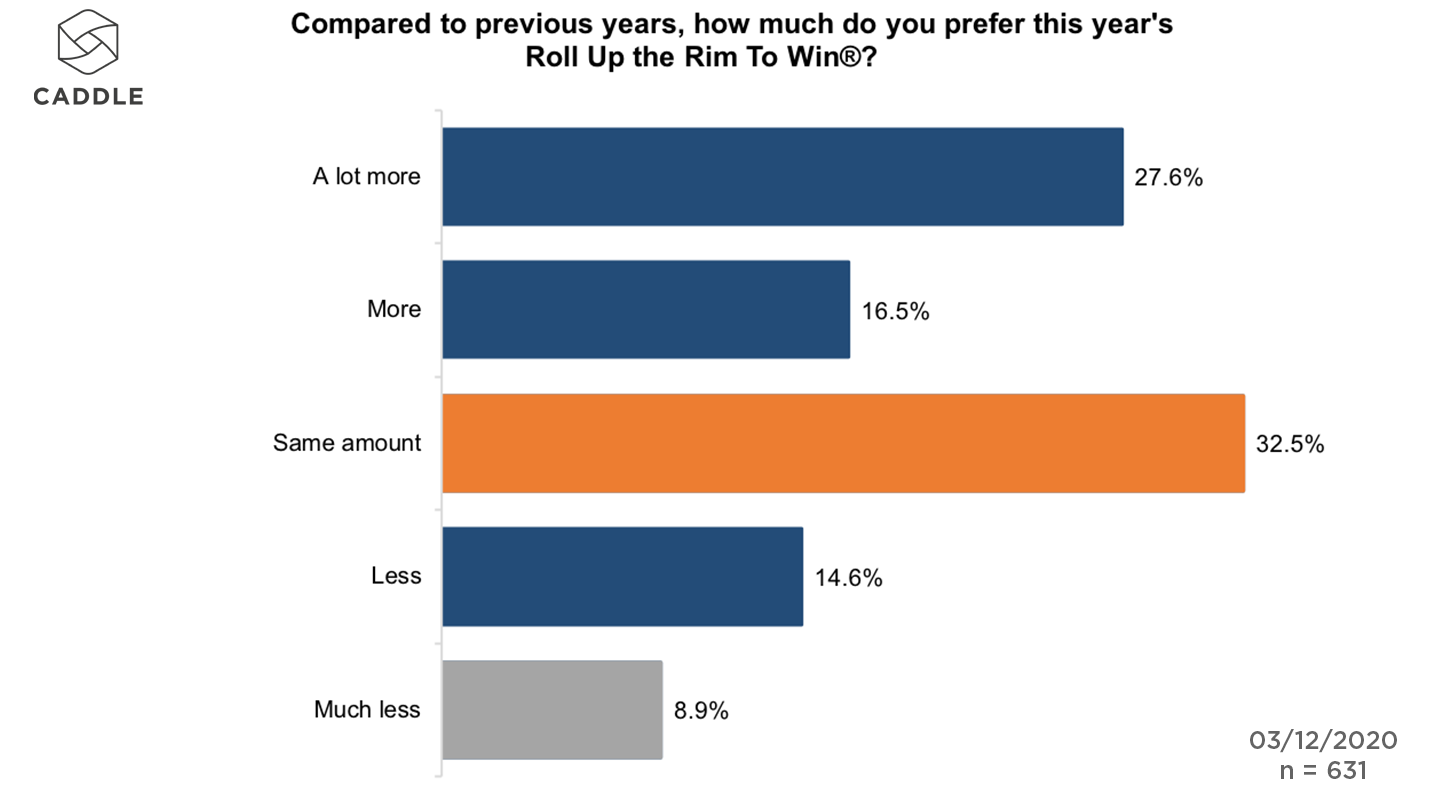
Key Takeaways
1. Know your audience
Sustainability and a more digital offering do not appear to be what Tim’s core market was looking for in the contest.
The goal of a contest should be promoting loyalty among core customers, and should be designed with them in mind.
2. Don’t write off digital
Despite the overall lack of approval for the new format, the fact that those who played were more receptive suggests there positives to build on.
Considering the disruption caused by the COVID-19 pandemic, as well as some inevitable consumer hesitancy about change, the data suggests a digital Roll Up The Rim could still work — so long as the messaging strategy is improved.
3. Prizes win participants
Across all age groups and genders our panel members much preferred the new format if they had participated and won a prize. This is the key to acceptance.
To further evolve Roll Up The Rim in 2021, Tim Hortons should base the campaign around increased odds of winning, and make this the key message, alongside the speed and convenience of a digital format.
4. Sustainability isn’t the key to contests
Environmental sustainability is arguably a hygiene factor, and as such should not be the main message of a contest campaign.
A perceived lack of environmental sustainability with the original format of Roll Up The Rim may have been a negative for the campaign. This does not mean that making sustainability the focus would be a positive factor that would attract consumers to the contest.
Make sure you never miss an insight. Sign up to the Caddle mailing list now.
To find out how you can build custom data with Caddle’s daily survey panel contact insights@caddle.ca
COVID-19 Insights: Widespread concern for fitness
40% of Canadians exercising less due to coronavirus
For better or worse, routines are the key to forming habits.
So what happens to our habits when all of our daily routines are disrupted like never before?
With social distancing measures in force, approximately 1 in 5 of the Caddle’s panel reported exercising a lot less.
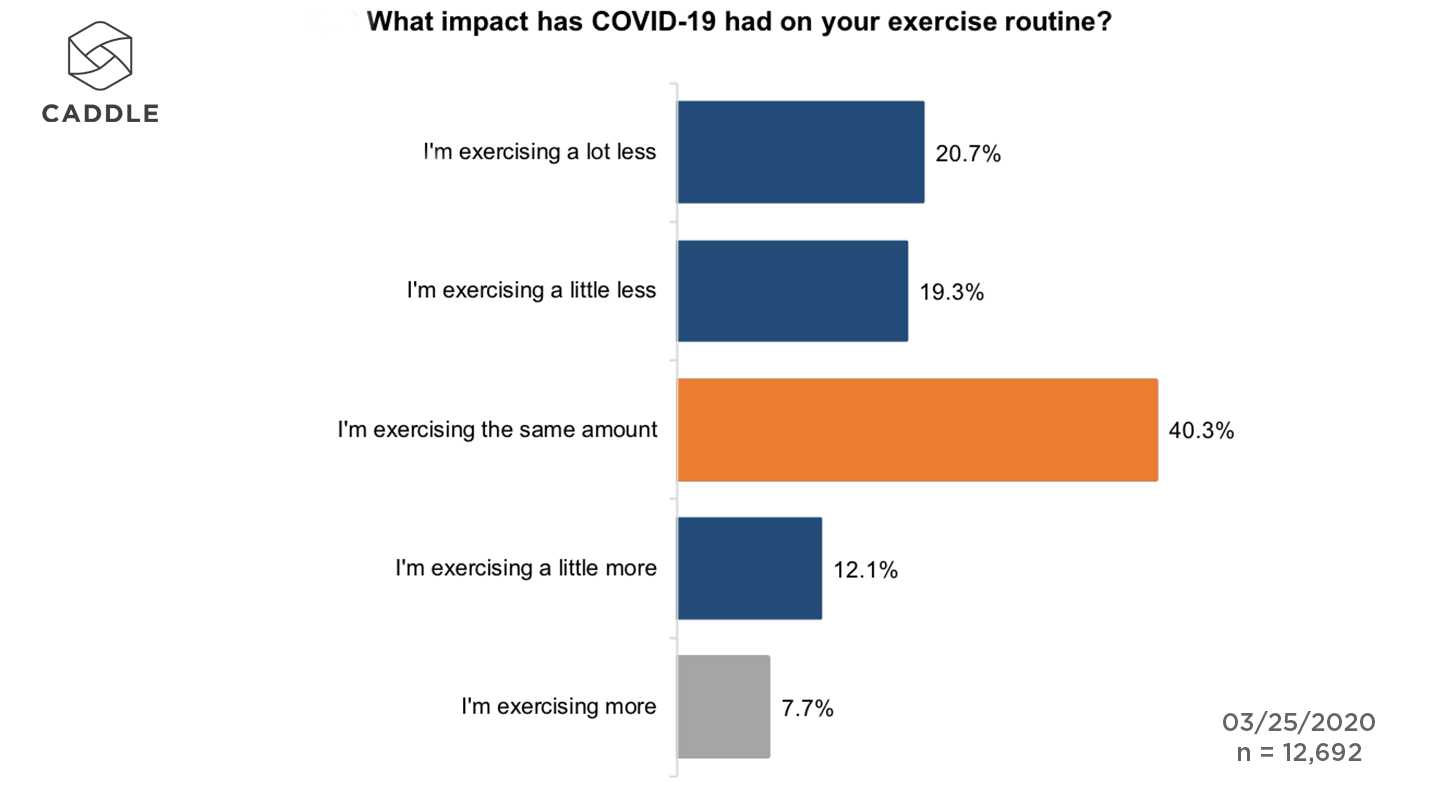
But how else is the pandemic impacting exercise and diet? Here’s what we found when we asked more than 12,000 Canadians via Caddle’s daily survey.
The impact on exercise
With 40% of the Caddle panel reporting that they are exercising less, concern about maintaining fitness is widespread. The same proportion said that social distancing measures meant they were concerned about their fitness.
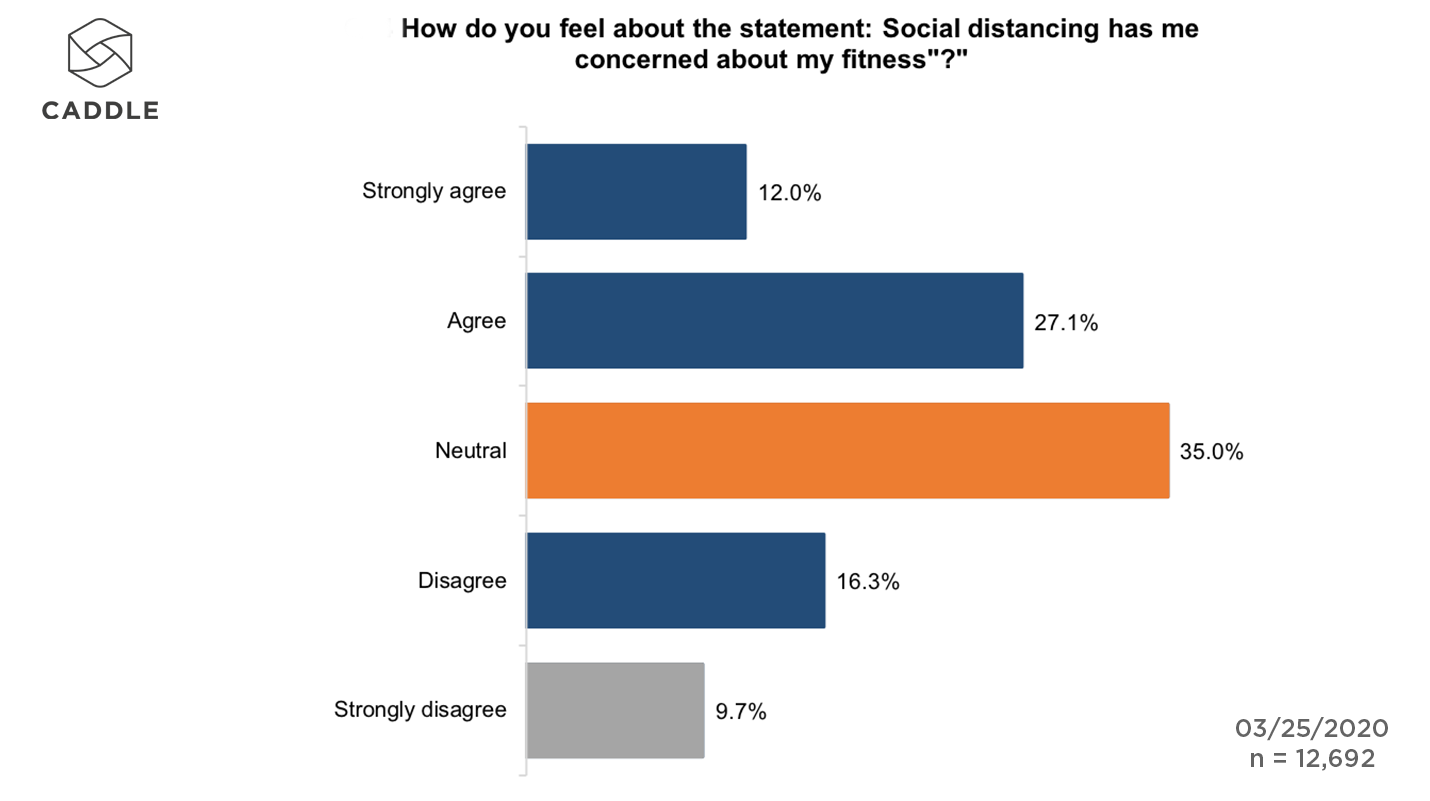
This was the case for the majority of Canadians who said they were exercising less, but also the majority those who said they were exercising more than before the coronavirus pandemic.
Both groups report being concerned about fitness levels, but show clear differences in willingness to take action. So what’s causing the difference?
Who’s working out at home?
Part of the exercise issue is age. Gen Z Canadians, as is the case with many of the questions in this week’s data, were most likely to report a change in habit as a result of social distancing.
Just over a quarter (27.1%) said their level of exercise had not been impacted by the pandemic, compared to 38.5% of Millennials and 42.5 of Gen X Canadians.
Gen Z was the generation with the highest percentage of people exercising less (46%) but also the largest proportion of respondents exercising more (26%).
Another factor appears to be attitudes to working out at home. Of Canadians who said they were getting more exercise than before the onset of social distancing, only 18% said they had never exercised at home before.
Of Canadians who reported they were exercising a lot less since social distancing began, 44% said they had never exercised at home before.
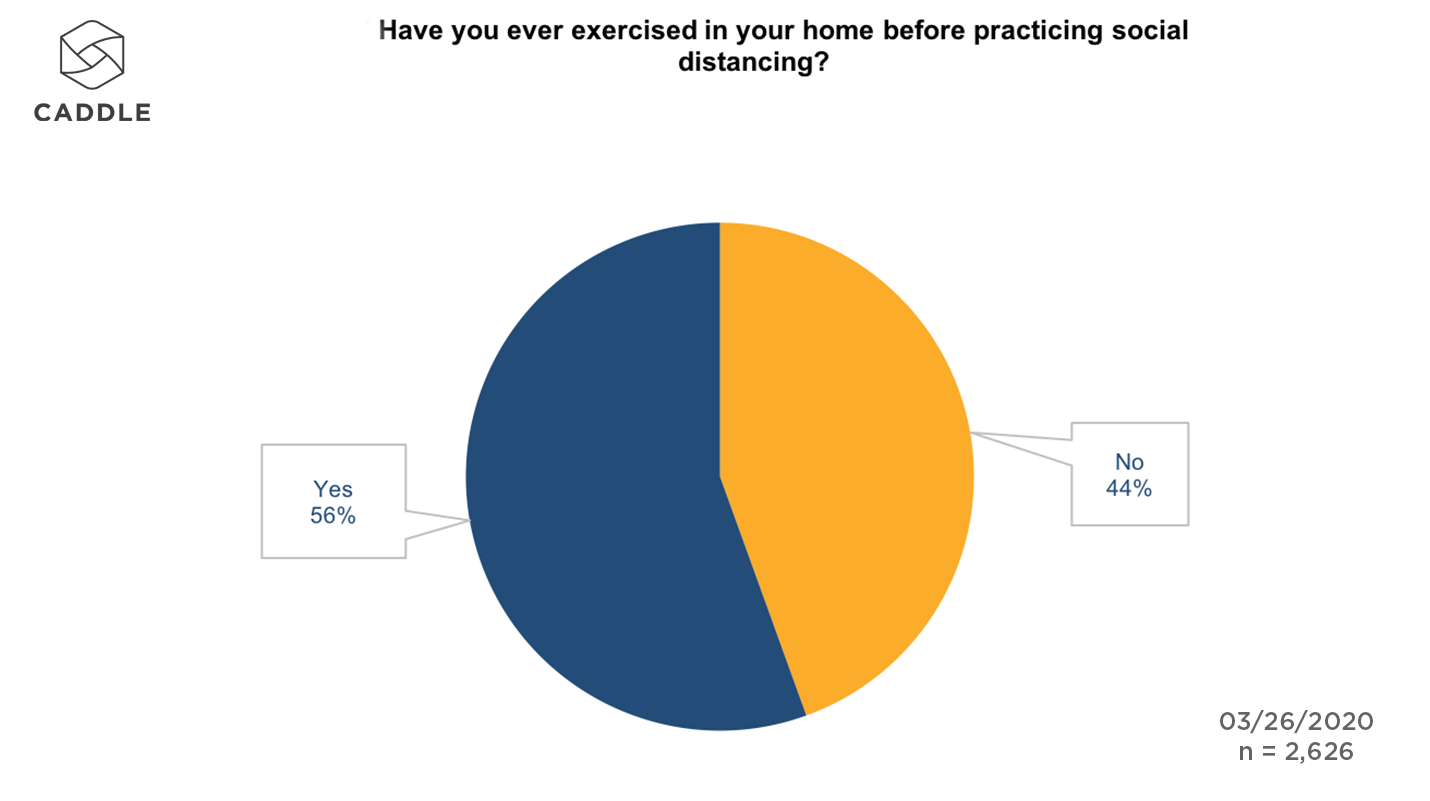
This difference is key as it raises a question about how much any rise in home workouts is driven by people trying it for the first time. Instead are we seeing people more used to exercising at home doubling down on fitness in isolation?
Who is building up their home gym?
Those who are exercising less, who over-index on never working out at home, currently have no plans to change this situation by purchasing equipment.
Those who were exercising less were also less likely to plan purchases home equipment — 57.9% said they were unlikely or very unlikely to buy home exercise equipment.
It isn’t all bad news for home exercise companies. Overall, around one in five of us feel it is likely we will buy home exercise equipment in response to social distancing.
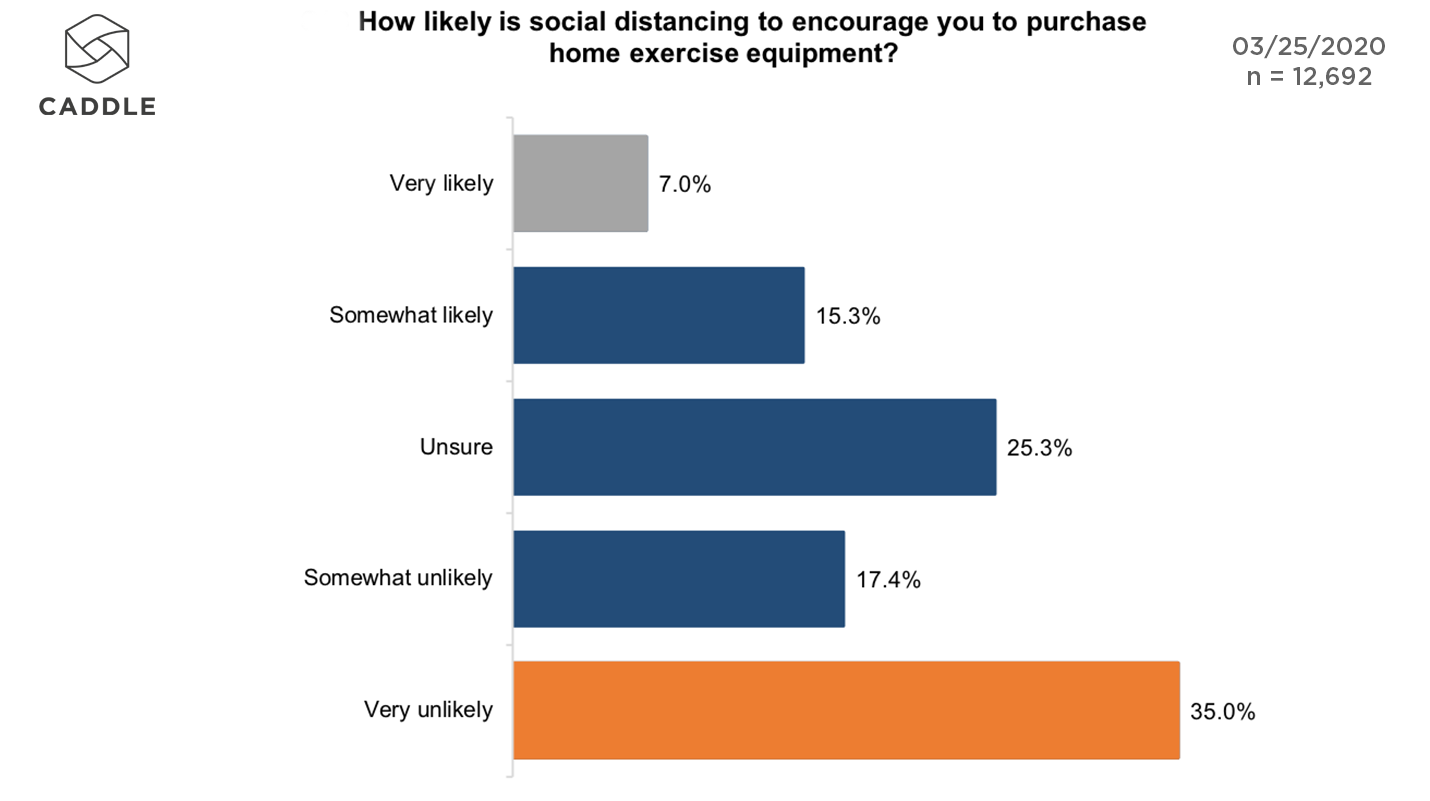
Meanwhile those who were exercising more, said they were likely to buy home exercise equipment. Almost half (48%) said they were likely or very likely to make a purchase. This could explain the relatively strong stock performance of brands like Peloton in the last month.
This is crucial for companies operating in this space. This data suggests that concerns about fitness will only go part of the way to attract new customers into the market. There seems to be a more significant initial barrier for some Canadians around exercising at home that needs to be overcome — even when they are concerned about a lack of exercise.
Îdentifying and overcoming this barrier could lead to much higher demand for home workout equipment.
Simply providing more exercise content does not appear to be enough of a trigger for everyone.
The people expecting to consume this content are the group who already say they are exercising more. Those who say they are exercising less, instead say they have no plans to increase their consumption of home workout content.
Is our diet getting worse?
So if we are concerned about getting less exercise are we trying to mitigate this with a healthier diet? Not necessarily.
For the most part, we’re just eating as we did before. Although social distancing seems to having the biggest impact on the eating habits of younger Canadians.
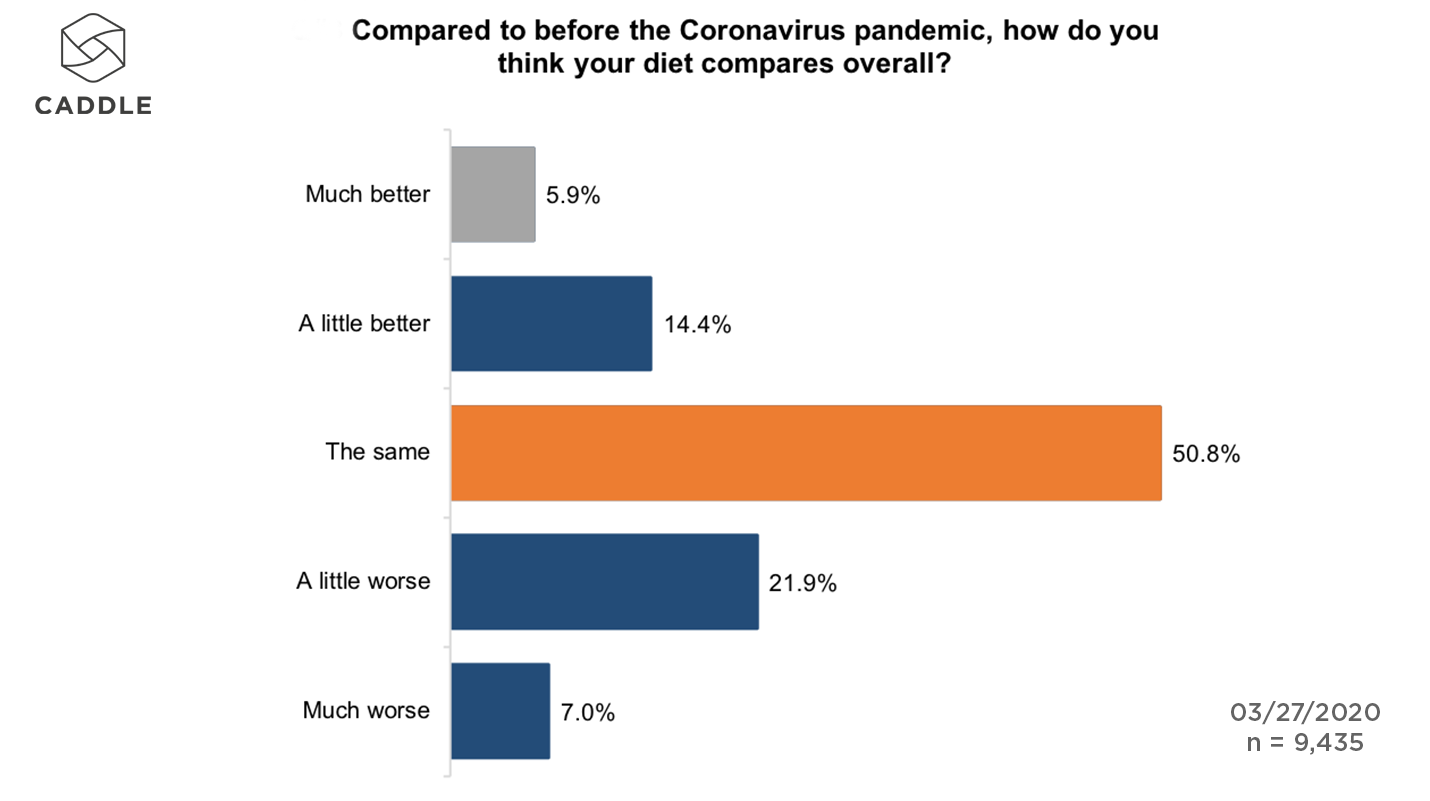
Over 60% of Baby Boomers reported no change in diet for better or worse, compared to 37% of Gen Z, and 46% of Millennials. At the same time, Millennials and Gen X were the age groups most likely to feel they were eating worse, with each generation’s net positive/negative responses coming in at -10.
However it isn’t all bad news. Gen Z were the most likely to feel they were eating better as a result of social distancing. Just over 30% of respondents said they were eating better — much more than the 21.6% of Millennials who reported an improvement in their diet.
What are we eating?
Despite more time spent at home, we apparently aren’t using that to prepare fancier meals from scratch. Nor are we looking for options that will cut carbs or sugar as ways to mitigate a less active lifestyle.
Asked what they look for most in a meal, the most popular choice was food that is quick and easy to make.
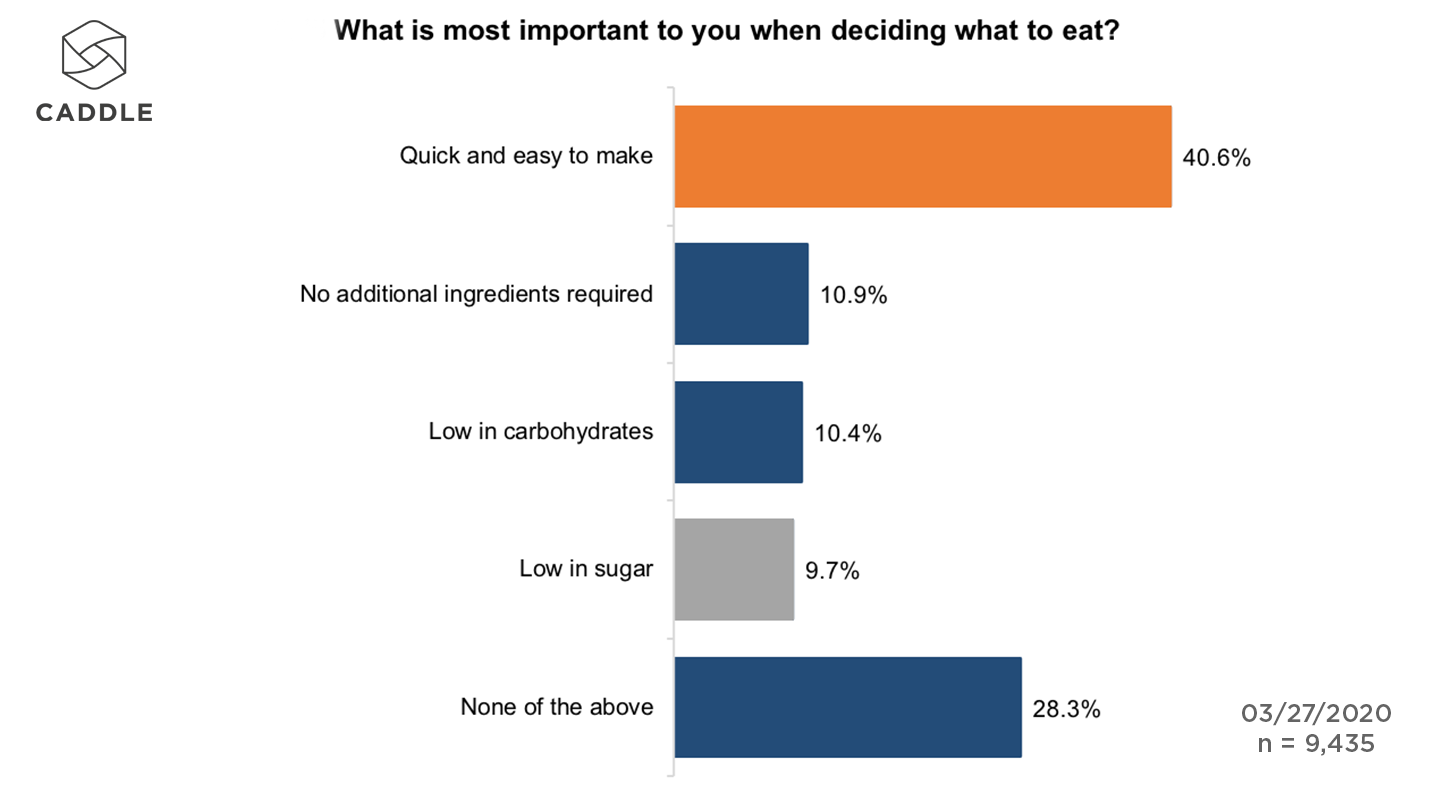
Alongside this, Caddle survey data suggests younger Canadians are indulging in more comfort food options.
For the panel overall, 29% said they were eating more comfort food, but for Gen Z this number was over 40%.
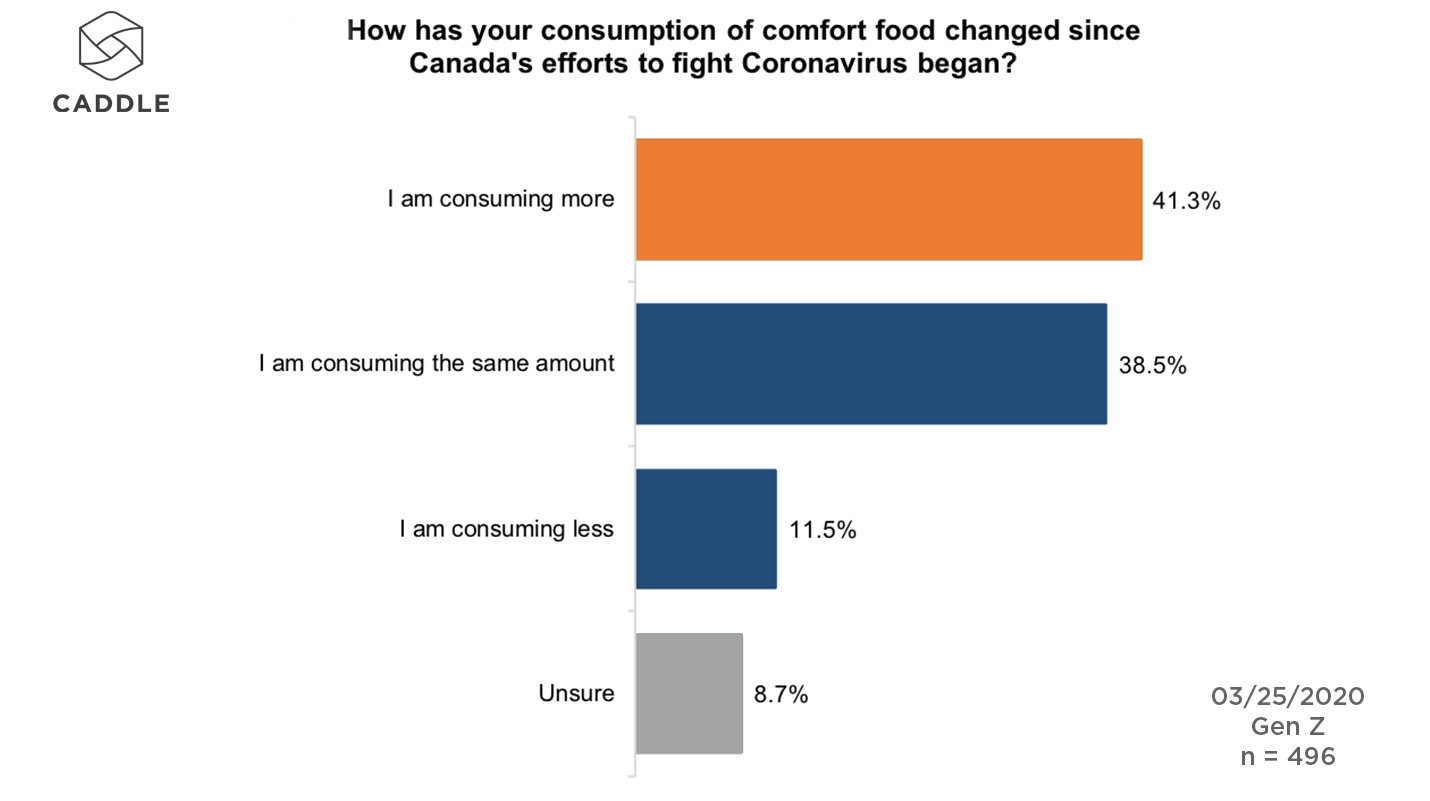
Are we drinking more?
While we might be concerned that we are eating less healthily, our alcohol consumption hasn’t necessarily gone up.
For the most part we are not drinking more. Across all age groups most Canadians reported that social distancing had not prompted a rise in their alcohol consumption.
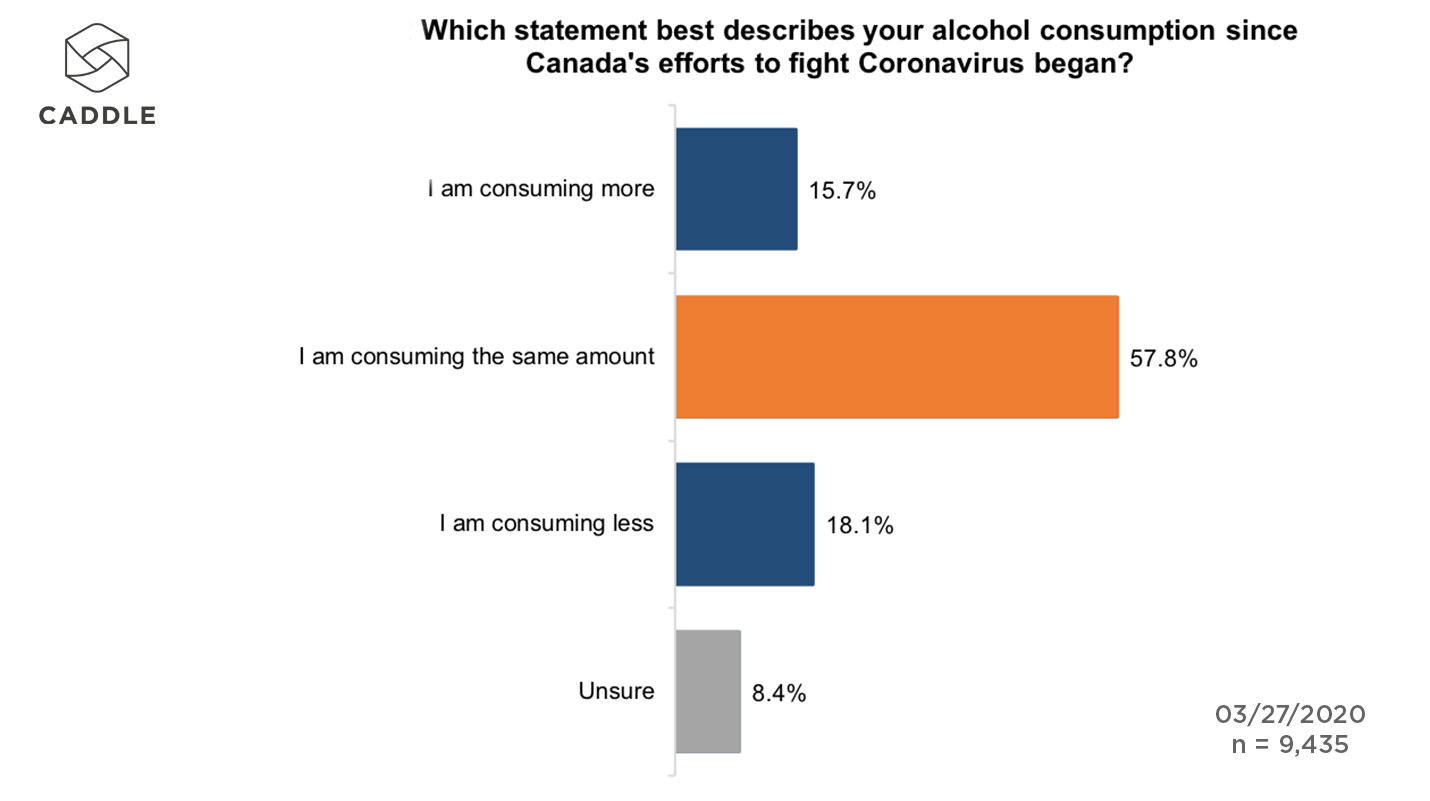
Gen Z was again an outlier, but not necessarily because this group is drinking more. While 25% are drinking more since measures to curb the pandemic were taken, 22% said they were drinking less.
So what does this mean?
Overall, the changes to diet and exercise caused by social distancing measures seem to be impacting younger Canadians the most.
Whether there was a positive or negative impact, younger Canadians were far more likely to say that social distancing has impacted what they eat, how much exercise they get, and how much they drink.
Are these changes representative of a broader openness to new things in unusual times? Potentially. Over a third of Gen Z Canadians reported trying to learn a new skill – the highest of any age group, and this only a matter of weeks into social distancing.
What we’re seeing is that younger generations are embracing change or being forced to radar faster.
The data suggests new habits are being formed right now. The question is: will they survive past the end of social isolation measures
